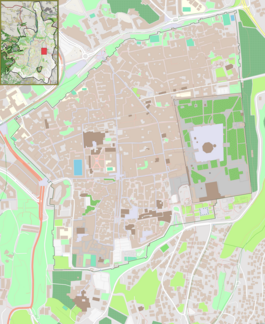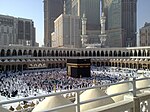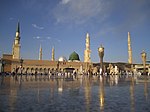Al-Aqsa
| Al-Aqsa (al-Masjid al-Aqṣā) | |
|---|---|
 Aerial view of the Al-Aqsa Mosque compound atop the Temple Mount | |
| Religion | |
| Affiliation | Islam |
| Ecclesiastical or organizational status | Mosque |
| Leadership | Imam Muhammad Ahmad Hussein |
| Status | Active |
| Location | |
| Location | Old City of Jerusalem |
| Administration | Jerusalem Islamic Waqf |
| Geographic coordinates | 31°46′41″N 35°14′10″E / 31.778°N 35.236°E |
| Architecture | |
| Type | Mosque architecture |
| Style | Early Islamic, Mamluk |
| Date established | 637 |
| Specifications | |
| Direction of façade | north-northwest |
| Capacity | c. 400,000 (estimate) |
| Dome(s) | Two large + tens of smaller ones |
| Minaret(s) | Four |
| Minaret height | 37 meters (121 ft) (tallest) |
| Materials | Limestone (external walls, minaret, facade) stalactite (minaret), gold, lead and stone (domes), white marble (interior columns) and mosaic |
| [1] | |
Al-Aqsa (/æl ˈæksə/; Arabic: الأَقْصَى, romanized: Al-Aqṣā) or al-Masjid al-Aqṣā (Arabic: المسجد الأقصى)[2] is the compound of Islamic religious buildings that sit atop the Temple Mount, also known as the Haram al-Sharif, in the Old City of Jerusalem, including the Dome of the Rock, many mosques and prayer halls, madrasas, zawiyas, khalwas and other domes and religious structures, as well as the four encircling minarets. It is considered the third holiest site in Islam. The compound's main congregational mosque or prayer hall is variously known as Al-Aqsa Mosque, Qibli Mosque or al-Jāmiʿ al-Aqṣā, while in some sources it is also known as al-Masjid al-Aqṣā; the wider compound is sometimes known as Al-Aqsa Mosque compound in order to avoid confusion.[3]
During the rule of the Rashidun caliph Umar (r. 634–644) or the Umayyad caliph Mu'awiya I (r. 661–680), a small prayer house on the compound was erected near the mosque's site. The present-day mosque, located on the south wall of the compound, was originally built by the fifth Umayyad caliph Abd al-Malik (r. 685–705) or his successor al-Walid I (r. 705–715) (or both) as a congregational mosque on the same axis as the Dome of the Rock, a commemorative Islamic monument. After being destroyed in an earthquake in 746, the mosque was rebuilt in 758 by the Abbasid caliph al-Mansur (r. 754–775). It was further expanded upon in 780 by the Abbasid caliph al-Mahdi (r. 775–785), after which it consisted of fifteen aisles and a central dome. However, it was again destroyed during the 1033 Jordan Rift Valley earthquake. The mosque was rebuilt by the Fatimid caliph al-Zahir (r. 1021–1036), who reduced it to seven aisles but adorned its interior with an elaborate central archway covered in vegetal mosaics; the current structure preserves the 11th-century outline.
During the periodic renovations undertaken, the ruling Islamic dynasties constructed additions to the mosque and its precincts, such as its dome, façade, minarets, and minbar and interior structure. Upon its capture by the Crusaders in 1099, the mosque was used as a palace; it was also the headquarters of the religious order of the Knights Templar. After the area was conquered by Saladin (r. 1174–1193) in 1187, the structure's function as a mosque was restored. More renovations, repairs, and expansion projects were undertaken in later centuries by the Ayyubids, the Mamluks, the Ottomans, the Supreme Muslim Council of British Palestine, and during the Jordanian annexation of the West Bank. Since the beginning of the ongoing Israeli occupation of the West Bank, the mosque has remained under the independent administration of the Jerusalem Waqf.
Al-Aqsa holds high geopolitical significance due to its location atop the Temple Mount, in close proximity to other historical and holy sites in Judaism, Christianity and Islam, and has been a primary flashpoint in the Israeli–Palestinian conflict.[4]
Definition
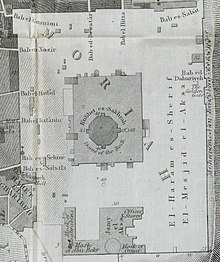
The English term "Al-Aqsa Mosque" is the translation of both al-Masjid al-Aqṣā (ٱلْمَسْجِد ٱلْأَقْصَىٰ) and Jāmiʿ al-Aqṣā (جَامِع ٱلْأَقْصَىٰ), which have distinct Islamic meanings in Arabic.[5][6][7] The former (al-Masjid al-Aqṣā) refers to the Quran's Surah 17 – "the farthest mosque" – traditionally refers to the entirety of the Temple Mount compound, while the latter name (Jāmiʿ al-Aqṣā) is used specifically for the silver-domed congregational mosque building.[5][6][7] Arabic and Persian writers such as 10th-century geographer al-Muqaddasi,[8] 11th-century scholar Nasir Khusraw,[8] 12th-century geographer al-Idrisi[9] and 15th-century Islamic scholar Mujir al-Din,[2][10] as well as 19th-century American and British Orientalists Edward Robinson,[5] Guy Le Strange and Edward Henry Palmer explained that the term Masjid al-Aqsa refers to the entire esplanade plaza also known as the Temple Mount or Haram al-Sharif ('Noble Sanctuary') – i.e. the entire area including the Dome of the Rock, the fountains, the gates, and the four minarets – because none of these buildings existed at the time the Quran was written.[6][11][12] Al-Muqaddasi referred to the southern building (the subject of this article) as Al Mughattâ ("the covered-part") and Nasir Khusraw referred to it with the Persian word Pushish (also the "covered part," exactly as "Al Mughatta") or the Maqsurah (a part-for-the-whole synecdoche).[8]
During the period of Mamluk[13] (1250–1517) and Ottoman rule (1517–1917), the wider compound began to also be popularly known as the Haram al-Sharif, or al-Ḥaram ash-Sharīf (Arabic: اَلْـحَـرَم الـشَّـرِيْـف), which translates as the "Noble Sanctuary". It mirrors the terminology of the Masjid al-Haram in Mecca;[14][15][16][17] This term elevated the compound to the status of Haram, which had previously only been reserved for the Masjid al-Haram in Mecca and the Al-Masjid an-Nabawi in Medina. Other Islamic figures disputed the haram status of the site.[18] Usage of the name Haram al-Sharif by local Palestinians has waned in recent decades, in favor of the traditional name of Al-Aqsa Mosque.[18]
History
Umayyad period
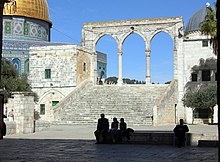
In 637, the Rashidun Caliphate under Umar, the father-in-law of the Islamic prophet Muhammad, besieged and captured Jerusalem from the Byzantine Empire. There are no contemporary records, but many traditions, about the origin of the main Islamic buildings on the Temple Mount.[19][20] A popular account from later centuries is that Umar was led to the place reluctantly by the Christian patriarch Sophronius.[21] He found it covered with rubbish, but the sacred Rock was found with the help of a converted Jew, Ka'b al-Ahbar.[21] Al-Ahbar advised Umar to build a mosque to the north of the rock, so that worshippers would face both the rock and Mecca, but instead Umar chose to build it to the south of the rock.[21] It became known as al-Aqsa Mosque. According to Muslim sources, Jews participated in the construction of the haram, laying the groundwork for both al-Aqsa and the Dome of the Rock mosques.[22] The first known eyewitness testimony is that of the pilgrim Arculf who visited about 670. According to Arculf's account as recorded by Adomnán, he saw a rectangular wooden house of prayer built over some ruins, large enough to hold 3,000 people.[19][23]
In 691, an octagonal Islamic building topped by a dome was built by the Caliph Abd al-Malik around the Foundation Stone, for a myriad of political, dynastic and religious reasons, built on local and Quranic traditions articulating the site's holiness, a process in which textual and architectural narratives reinforced one another.[24][25][26] The shrine became known as the Dome of the Rock (قبة الصخرة, Qubbat as-Sakhra). (The dome itself was covered in gold in 1920.) In 715 the Umayyads, led by the Caliph al-Walid I, built al-Aqsa Mosque (المسجد الأقصى, al-Masjid al-'Aqṣā, lit. "Furthest Mosque"), corresponding to the Islamic belief of Muhammad's miraculous nocturnal journey as recounted in the Quran and hadith. The term "Noble Sanctuary" or "Haram al-Sharif", as it was called later by the Mamluks and Ottomans, refers to the whole area that surrounds that Rock.[27]
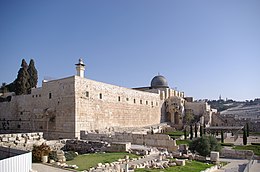
A mostly wooden, rectangular prayer hall on the Temple Mount site with a capacity for 3,000 worshippers is attested by the Gallic monk Arculf during his pilgrimage to Jerusalem in c. 679–682.[28][29] Its precise location is not known.[29] The art historian Oleg Grabar deems it likely that it was close to the present prayer hall,[29] while the historian Yildirim Yavuz asserts it stood at the present site of the Dome of Rock.[30] The architectural historian K. A. C. Creswell notes that Arculf's attestation lends credibility to claims by some Islamic traditions and medieval Christian chronicles, which he otherwise deems legendary or unreliable, that the second Rashidun caliph, Umar (r. 634–644), ordered the construction of a primitive mosque on the Temple Mount. However, Arculf visited Palestine during the reign of Caliph Mu'awiya I (r. 661–680), founder of the Syria-based Umayyad Caliphate.[28] Mu'awiya had been governor of Syria, including Palestine, for about twenty years before becoming caliph and his accession ceremony was held in Jerusalem. The 10th-century Jerusalemite scholar al-Mutahhar ibn Tahir al-Maqdisi claims Mu'awiya built a mosque on the Haram.[31]
There is disagreement as to whether the present prayer hall was originally built by the Umayyad caliph Abd al-Malik (r. 685–705) or his successor, his son al-Walid I (r. 705–715). Several architectural historians hold that Abd al-Malik commissioned the project and that al-Walid finished or expanded it.[a] Abd al-Malik inaugurated great architectural works on the Temple Mount, including construction of the Dome of the Rock in c. 691. A common Islamic tradition holds that Abd al-Malik simultaneously commissioned the Dome of the Rock and the al-Aqsa Mosque.[39] As both were intentionally built on the same axis, Grabar comments that the two structures form "part of an architecturally thought-out ensemble comprising a congregational and a commemorative building", the al-Aqsa Mosque and the Dome of the Rock, respectively.[40][b] Guy le Strange claims that Abd al-Malik used materials from the destroyed Church of Our Lady to build the mosque and points to possible evidence that substructures on the southeast corners of the mosque are remains of the church.[41]
The earliest source indicating al-Walid's work on the mosque is the Aphrodito Papryi.[42] These contain the letters between al-Walid's governor of Egypt in December 708–June 711 and a government official in Upper Egypt which discuss the dispatch of Egyptian laborers and craftsmen to help build the al-Aqsa Mosque, referred to as the "Mosque of Jerusalem".[36] The referenced workers spent between six months and a year on the construction.[43] Several 10th and 13th-century historians credit al-Walid for founding the mosque, though the historian Amikam Elad doubts their reliability on the matter.[c] In 713–714, a series of earthquakes ravaged Jerusalem, destroying the eastern section of the mosque, which was subsequently rebuilt by al-Walid's order. He had gold from the Dome of the Rock melted to use as money to finance the repairs and renovations. He is credited by the early 15th-century historian al-Qalqashandi for covering the mosque's walls with mosaics.[38] Grabar notes that the Umayyad-era mosque was adorned with mosaics, marble, and "remarkable crafted and painted woodwork".[40] The latter are preserved partly in the Palestine Archaeological Museum and partly in the Islamic Museum.[40]
Estimates of the size of the Umayyad-built mosque by architectural historians range from 112 by 39 meters (367 ft × 128 ft)[45] to 114.6 by 69.2 meters (376 ft × 227 ft).[30] The building was rectangular.[30] In the assessment of Grabar, the layout was a modified version of the traditional hypostyle mosque of the period. Its "unusual" characteristic was that its aisles laid perpendicular to the qibla wall. The number of aisles is not definitively known, though fifteen is cited by a number of historians. The central aisle, double the width of the others, was probably topped by a dome.[40]
The last years of Umayyad rule were turbulent for Jerusalem. The last Umayyad caliph, Marwan II (r. 744–750), punished Jerusalem's inhabitants for supporting a rebellion against him by rival princes, and tore down the city's walls.[46] In 746, the al-Aqsa Mosque was ruined in an earthquake. Four years later, the Umayyads were toppled and replaced by the Iraq-based Abbasid Caliphate.[47]
Abbasid period
The Abbasids generally exhibited little interest in Jerusalem,[48] though the historian Shelomo Dov Goitein notes they "paid special tribute" to the city during the early part of their rule,[46] and Grabar asserts that the early Abbasids' work on the mosque suggests "a major attempt to assert Abbasid sponsorship of holy places".[49] Nevertheless, in contrast to the Umayyad period, maintenance of the al-Aqsa Mosque during Abbasid rule often came at the initiative of the local Muslim community, rather than from the caliph.[47][40] The second Abbasid caliph, al-Mansur (r. 754–775), visited Jerusalem in 758, on his return from the Hajj pilgrimage to Mecca. He found the structures on the Haram in ruins from the 746 earthquake, including the al-Aqsa Mosque. According to the tradition cited by Mujir al-Din, the caliph was beseeched by the city's Muslim residents to fund the buildings' restoration. In response, he had the gold and silver plaques covering the mosque's doors converted into dinars and dirhams to finance the reconstruction.[48]
A second earthquake damaged most of al-Mansur's repairs, except for the southern portion near the mihrab (prayer niche indicating the qibla). In 780, his successor, al-Mahdi, ordered its reconstruction, mandating that his provincial governors and other commanders each contribute the cost of a colonnade.[50] Al-Mahdi's renovation is the first known to have written records describing it.[51] The Jerusalemite geographer al-Muqaddasi, writing in 985, provided the following description:
This mosque is even more beautiful than that of Damascus ... the edifice [after al-Mahdi's reconstruction] rose firmer and more substantial than ever it had been in former times. The more ancient portion remained, even like a beauty spot, in the midst of the new ... the Aqsa mosque has twenty-six doors ... The centre of the Main-building is covered by a mighty roof, high pitched and gable-wise, over which rises a magnificent dome.[52]
Al-Muqaddasi further noted that the mosque consisted of fifteen aisles aligned perpendicularly to the qibla and possessed an elaborately decorated porch with the names of the Abbasid caliphs inscribed on its gates.[49] According to Hamilton, al-Muqaddasi's description of the Abbasid-era mosque is corroborated by his archaeological findings in 1938–1942, which showed the Abbasid construction retained some parts of the older structure and had a broad central aisle topped by a dome.[53] The mosque described by al-Muqaddasi opened to the north, toward the Dome of the Rock, and, unusually according to Grabar, to the east.[49]
Other than al-Mansur and al-Mahdi, no other Abbasid caliphs visited Jerusalem or commissioned work on the al-Aqsa Mosque, though Caliph al-Ma'mun (r. 813–833) ordered significant work elsewhere on the Haram. He also contributed a bronze portal to the mosque's interior, and the geographer Nasir Khusraw noted during his 1047 visit that al-Ma'mun's name was inscribed on it.[54] Abd Allah ibn Tahir, the Abbasid governor of the eastern province of Khurasan (r. 828–844), is credited by al-Muqaddasi for building a colonnade on marble pillars in front of the fifteen doors on the mosque's front (north) side.[55]
Fatimid period
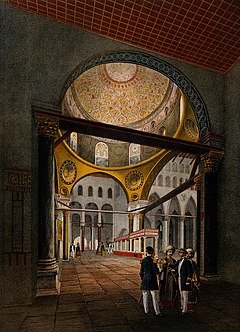
In 970, the Egypt-based Fatimid Caliphate conquered Palestine from the Ikhshidids, nominal allegiants of the Abbasids. Unlike the Abbasids and the Muslim inhabitants of Jerusalem, who were Sunnis, the Fatimids followed Shia Islam in its Isma'ili form.[56] In 1033, another earthquake severely damaged the mosque. The Fatimid caliph al-Zahir (r. 1021–1036) had the mosque reconstructed between 1034 and 1036, though work was not completed until 1065, during the reign of Caliph al-Mustansir (r. 1036–1094).[49]
The new mosque was considerably smaller, reduced from fifteen aisles to seven,[49] probably a reflection of the local population's significant decline by this time.[57][d] Excluding the two aisles on each side of the central nave, each aisle was made up of eleven arches running perpendicular to the qibla. The central nave was twice the breadth of the other aisles and had a gabled roof with a dome.[60][e] The mosque likely lacked the side doors of its predecessor.[49]
A prominent and distinctive feature of the new construction was the rich mosaic program endowed to the drum of the dome, the pendentives leading to the dome, and the arch in front of the mihrab.[60][61] These three adjoining areas covered by the mosaics are collectively referred to as the "triumphal arch" by Grabar or the "maqsura" by Pruitt.[60] Mosaic designs were rare in Islamic architecture in the post-Umayyad era and al-Zahir's mosaics were a revival of this Umayyad architectural practice, including Abd al-Malik's mosaics in the Dome of the Rock, but on a larger scale. The drum mosaic depicts a luxurious garden inspired by the Umayyad or Classical style. The four pendentives are gold and characterized by indented roundels with alternating gold and silver planes and patterns of peacock's eyes, eight-pointed stars, and palm fronds. On the arch are large depictions of vegetation emanating from small vases.[62][61]
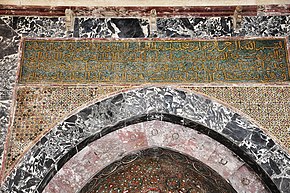
Atop the mihrab arch is a lengthy inscription in gold directly linking the al-Aqsa Mosque with Muhammad's Night Journey (the isra and mi'raj) from the "masjid al-haram" to the "masjid al-aqsa".[63] It marked the first instance of this Quranic verse being inscribed in Jerusalem, leading Grabar to hypothesize that it was an official move by the Fatimids to magnify the site's sacred character.[57] The inscription credits al-Zahir for renovating the mosque and two otherwise unknown figures, Abu al-Wasim and a sharif, al-Hasan al-Husayni, for supervising the work.[63][f]
Nasir Khusraw described the mosque during his 1047 visit.[64] He deemed it "very large", measuring 420 by 150 cubits on its western side. The distance between each "sculptured" marble column, 280 in number, was six cubits. The columns were supported by stone arches and lead joints.[65] He noted the following features:
... the mosque is everywhere flagged with coloured marble ... The Maksurah [or space railed off for the officials] is facing the centre of the south wall [of the Mosque and Haram Area], and is of such size as to contain sixteen columns. Above rises a mighty dome that is ornamented with enamel work.[65]
Al-Zahir's substantial investment in the Haram, including the al-Aqsa Mosque, amid the political instability in the capital Cairo, rebellions by Bedouin tribes, especially the Jarrahids of Palestine, and plagues, indicate the caliph's "commitment to Jerusalem", in Pruitt's words.[66] Although the city had experienced decreases in its population in the preceding decades, the Fatimids attempted to build up the magnificence and symbolism of the mosque, and the Haram in general, for their own religious and political reasons.[g] The present-day mosque largely retains al-Zahir's plan.[69]
Fatimid investment in Jerusalem ground to a halt toward the end of the 11th century as their rule became further destabilized. In 1071, a Turkish mercenary, Atsiz, was invited by the city's Fatimid governor to rein in the Bedouin, but he turned on the Fatimids, besieging and capturing Jerusalem that year. A few years later, the inhabitants revolted against him, and were slaughtered by Atsiz, including those who had taken shelter in the al-Aqsa Mosque. He was killed by the Turkish Seljuks in 1078, establishing Seljuk rule over the city, which lasted until the Fatimids regained control in 1098.[70]
Crusader/Ayyubid/Mamluk period
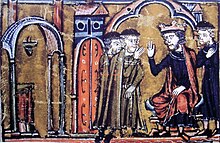
Jerusalem was captured by the Crusaders in 1099, during the First Crusade. They named the mosque Templum Solomonis (Solomon's Temple), distinguishing it from the Dome of the Rock, which they named Templum Domini (Temple of God). While the Dome of the Rock was turned into a Christian church under the care of the Augustinians,[71] the Qibli mosque was used as a royal palace and also as a stable for horses. In 1119, the Crusader king accommodated the headquarters of the Knights Templar next to his palace within the building.[72] This was probably by Baldwin II of Jerusalem and Warmund, Patriarch of Jerusalem at the Council of Nablus in January 1120.[73] During this period, the building underwent some structural changes, including the expansion of its northern porch, and the addition of an apse and a dividing wall. A new cloister and church were also built at the site, along with various other structures.[72] The Templars constructed vaulted western and eastern annexes to the building; the western currently serves as the women's mosque and the eastern as the Islamic Museum.[74] The Temple Mount had a mystique because it was above what were believed to be the ruins of the Temple of Solomon.[75][76]
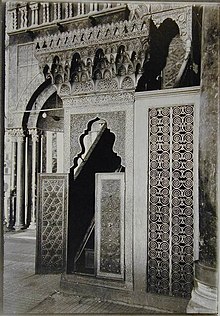
Following the 1187 siege and recapture of Jerusalem, Saladin removed all traces of Crusader activity at the site, removing structures such as toilets and grain stores installed by the Crusaders, and oversaw various repairs and renovations at the site, returning it to its role as a mosque in time for Friday prayers within a week of his capture of the city.[77]
The ivory-set Minbar of the al-Aqsa Mosque, commissioned earlier by the Zengid sultan Nur al-Din but only completed after his death, was also added to the mosque in November 1187 by Saladin.[78] The Ayyubid sultan of Damascus, Al-Mu'azzam Isa, also built the northern porch of the mosque with three gates in 1218.[74] Further building work was carried out under the Mamluks.[79] In 1345, the Mamluks under al-Kamil Shaban added two naves and two gates to the mosque's eastern side.[74]
There are several Mamluk buildings on and around the Haram esplanade, such as the late 15th-century al-Ashrafiyya Madrasa and Sabil (fountain) of Qaytbay. The Mamluks also raised the level of Jerusalem's Central or Tyropoean Valley bordering the Temple Mount from the west by constructing huge substructures, on which they then built on a large scale. The Mamluk-period substructures and over-ground buildings are thus covering much of the Herodian western wall of the Temple Mount.
Early modern period
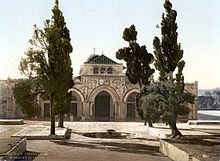
After the Ottomans assumed power in 1517, they did not undertake any major renovations or repairs to the mosque itself, but they did to the Noble Sanctuary as a whole. This included building the Fountain of Qasim Pasha (1527), restoring the Pool of Raranj, and building three free-standing domes—the most notable being the Dome of the Prophet built in 1538. All construction was ordered by the Ottoman governors of Jerusalem and not the sultans themselves.[80] The sultans did make additions to existing minarets, however.[80]
In 1816, the mosque was restored by Governor Sulayman Pasha al-Adil after having been in a dilapidated state.[81]
British Mandate period
Between 1922 and 1924, the Dome of the Rock and Qibli Mosque were both restored by the Supreme Muslim Council,[82] under Amin al-Husayni (the Grand Mufti of Jerusalem), who commissioned Turkish architect Ahmet Kemalettin Bey to restore al-Aqsa Mosque and the monuments in its precincts. The council also commissioned British architects, Egyptian engineering experts and local officials to contribute to and oversee the repairs and additions which were carried out in 1924–25 by Kemalettin. The renovations included reinforcing the mosque's ancient Umayyad foundations, rectifying the interior columns, replacing the beams, erecting a scaffolding, conserving the arches and drum of the main dome's interior, rebuilding the southern wall, and replacing timber in the central nave with a slab of concrete. The renovations also revealed Fatimid-era mosaics and inscriptions on the interior arches that had been covered with plasterwork. The arches were decorated with gold and green-tinted gypsum and their timber tie beams were replaced with brass. A quarter of the stained glass windows also were carefully renewed so as to preserve their original Abbasid and Fatimid designs.[83]
Severe damage was caused by the 1837 and 1927 earthquakes, but the mosque was repaired in 1938 and 1942.[74] Italian Fascist leader Benito Mussolini donated Carrara marble columns in the late 30s.[84]
An earthquake in 1927 and a small tremor in the summer of 1937 eventually brought down the roof of the Aqsa mosque, prompting the reconstruction of the upper part of the north wall of the mosque and the internal refacing of the whole; the partial reconstruction of the jambs and lintels of the central doors; the refacing of the front of five bays of the porch; and the demolition of the vaulted buildings that formerly adjoined the east side of the mosque.[85]
During his excavations in the 1930s, Robert Hamilton uncovered portions of a multicolor mosaic floor with geometric patterns, but did not publish them.[86] The date of the mosaic is disputed: Zachi Dvira considers that they are from the pre-Islamic Byzantine period, while Baruch, Reich and Sandhaus favor a much later Umayyad origin on account of their similarity to a mosaic from an Umayyad palace excavated adjacent to the Temple Mount's southern wall.[86] By comparing the photographs to Hamilton's excavation report, Di Cesare determined that they belong to the second phase of mosque construction in the Umayyad period.[87] Moreover, the mosaic designs were common in Islamic, Jewish and Christian buildings from the 2nd to the 8th century.[87] Di Cesare suggested that Hamilton didn't include the mosaics in his book because they were destroyed to explore beneath them.[87]
After 1948
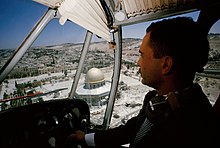
Since 1948, the Al-Aqsa Mosque compound has been under the custodianship of the Hashemite rulers of Jordan, administered through the Jerusalem Waqf, the current version of which was instituted by Jordan after its conquest and occupation of the West Bank, including East Jerusalem, during the 1948 war.[88] The Jerusalem Waqf remained under Jordanian control after Israel occupied the Old City of Jerusalem during the Six-Day War of June 1967, though control over access to the site passed to Israel.[89]
Jordan undertook two renovations of the Dome of the Rock, replacing the leaking, wooden inner dome with an aluminum dome in 1952, and, when the new dome leaked, carrying out a second restoration between 1959 and 1964.[82]
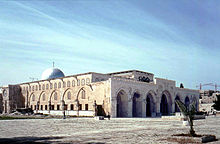
On 21 August 1969, a fire was started by a visitor from Australia named Denis Michael Rohan,[90] an evangelical Christian who hoped that by burning down al-Aqsa Mosque he would hasten the Second Coming of Jesus.[91] In response to the incident, a summit of Islamic countries was held in Rabat that same year, hosted by Faisal of Saudi Arabia, the then king of Saudi Arabia. The al-Aqsa fire is regarded as one of the catalysts for the formation of the Organisation of the Islamic Conference (OIC, now the Organisation of Islamic Cooperation) in 1972.[92]
Following the fire, the dome was reconstructed in concrete and covered with anodized aluminium, instead of the original ribbed lead enamel work sheeting. In 1983, the aluminium outer covering was replaced with lead to match the original design by az-Zahir.[93]
In the 1980s, Ben Shoshan and Yehuda Etzion, both members of the Israeli radical Gush Emunim Underground group, plotted to blow up the Al-Aqsa Mosque and Dome of the Rock. Etzion believed that blowing up the two mosques would cause a spiritual awakening in Israel, and would solve all the problems of the Jewish people. They also hoped the Third Temple would be built on the location of the mosque.[94][95]
In 1990, the Waqf began construction of a series of outdoor minbar (pulpits) to create open-air prayer areas for use on popular holy days.[96] A monument to the victims of the Sabra and Shatila massacre was also erected.[96] In 1996, the Waqf began underground construction of the new el-Marwani Mosque in the southeastern corner of the Temple Mount. The area was claimed by the Waqf as a space that served in earlier Islamic periods as a place of prayer, but some saw the move as a part of a "political agenda"[97] and a "pretext" for the Islamization of the underground space, and believed it had been instigated to prevent the site being used a synagogue for Jewish prayers.[96][98] A spate over the use of the Golden Gate (Bab adh-Dhahabi) gatehouse as a mosque has followed in 2019.[99]
On 28 September 2000, then-opposition leader of Israel Ariel Sharon visited the Al-Aqsa Mosque compound along with 1,000 armed guards. The visit was provocative and helped spark the five-year uprising by the Palestinians commonly known as the Second Intifada, but also referred to as the al-Aqsa Intifada after the incident.[100][101][102]
On 5 November 2014, Israeli police entered the main prayer hall itself for the first time since capturing Jerusalem in 1967, according to Sheikh Azzam Al-Khatib, director of the Islamic Waqf. Previous media reports of 'storming Al-Aqsa' referred to the whole compound rather than the Qibli Mosque prayer hall itself.[103]
Buildings and architecture
The entire precinct or courtyard (sahn) of the Al-Aqsa Mosque compound can host more than 400,000 worshippers, making it one of the largest mosques in the world.[104][105] The compound comprises numerous buildings, including the Dome of the Rock, Qibli Mosque, four encircling minarets, various other domed shrines and the entry gates.
Dome of the Rock
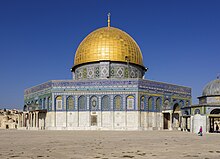
The Dome of the Rock is the gold-domed Islamic shrine at the center of the Al-Aqsa Mosque compound. Its initial construction was undertaken by the Umayyad Caliphate on the orders of Abd al-Malik during the Second Fitna in 691–692 CE. The original dome collapsed in 1015 and was rebuilt in 1022–23. The Dome of the Rock is the world's oldest surviving work of Islamic architecture,[106][107] and its architecture and mosaics were modelled after nearby Byzantine churches and palaces,[108] although its outside appearance was significantly changed during the Ottoman period and again in the modern period, notably with the addition of the gold-plated roof, in 1959–61 and again in 1993. The octagonal plan of the structure may have been influenced by the Byzantine-era Church of the Seat of Mary (also known as Kathisma in Greek and al-Qadismu in Arabic), which was built between 451 and 458 on the road between Jerusalem and Bethlehem.[108]
The dome sits on a slightly raised platform accessed by eight staircases, each of which is topped by a free-standing arcade known in Arabic as the qanatir or mawazin. The arcades were erected in different periods from the 10th to 15th centuries.[109]
Architecture
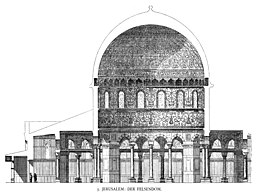
The Dome of the Rock's structure is basically octagonal. It is capped at its centre by a dome, approximately 20 m (66 ft) in diameter, mounted on an elevated circular drum standing on 16 supports (4 tiers and 12 columns).[111] Surrounding this circle is an octagonal arcade of 24 piers and columns.[112] The octagonal arcade and the inner circular drum create an inner ambulatorium that encircles the holy rock. The outer walls are also octagonal. They each measure approximately 18 m (60 ft) wide and 11 m (36 ft) high.[111] The outer and inner octagon create a second, outer ambulatorium surrounding the inner one. Both the circular drum and the exterior walls contain many windows.[111]
The interior of the dome is lavishly decorated with mosaic, faience and marble, much of which was added several centuries after its completion. It also contains Qur'anic inscriptions. They vary from today's standard text (mainly changes from the first to the third person) and are mixed with pious inscriptions not in the Quran.[113] The decoration of the outer walls went through two major phases: the initial Umayyad scheme comprised marble and mosaics, much like the interior walls.[114] Sixteenth-century Ottoman sultan Suleyman the Magnificent replaced it with Turkish faience tiles.[114] The Ottoman tile decoration was replaced in the 1960s with faithful copies produced in Italy.[114]
Encircling archways
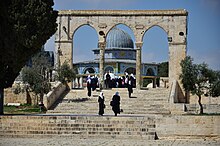
Surrounding the Dome of the Rock, at the top of each of the eight flights of stairs up onto the platform on which it sits, are eight freestanding sets of archways called "Al-Mawazin", each supported by 2 to 4 columns, set between two pilasters.
It is likely that some of the archways date back to the period of the construction of the Dome of the Rock and that they were an integral part of its initial construction plan. In particular, it is thought that the four arcades facing the four entrances were built at the same time as the dome.[115]
Al-Aqsa/Qibli Mosque
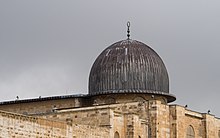
The Al-Aqsa Mosque or Qibli Mosque is the main congregational mosque prayer hall of the Al-Aqsa Mosque compound, with capacity for around 5,000 worshippers. It has been destroyed and rebuilt several times.
During the rule of the Rashidun caliph Umar (r. 634–644) or the Umayyad caliph Mu'awiya I (r. 661–680), a small prayer house on the compound was erected near the mosque's site. The present-day mosque, located on the south wall of the compound, was originally built by the fifth Umayyad caliph Abd al-Malik (r. 685–705) or his successor al-Walid I (r. 705–715) (or both) as a congregational mosque on the same axis as the Dome of the Rock, a commemorative Islamic monument. After being destroyed in an earthquake in 746, the mosque was rebuilt in 758 by the Abbasid caliph al-Mansur. It was further expanded upon in 780 by the Abbasid caliph al-Mahdi, after which it consisted of fifteen aisles and a central dome. However, it was again destroyed during the 1033 Jordan Rift Valley earthquake. The mosque was rebuilt by the Fatimid caliph al-Zahir (r. 1021–1036), who reduced it to seven aisles but adorned its interior with an elaborate central archway covered in vegetal mosaics; the current structure preserves the 11th-century outline.
Nothing remains of the original dome built by Abd al-Malik. The present-day dome mimicks that of az-Zahir, which consisted of wood plated with lead enamelwork, but which was destroyed by fire in 1969. Today it is made of concrete with lead sheeting.[93] Al-Aqsa's dome is one of the few domes to be built in front of the mihrab during the Umayyad and Abbasid periods, the others being the Umayyad Mosque in Damascus (715) and the Great Mosque of Sousse (850).[116] The interior of the dome is painted with 14th-century-era decorations. During the 1969 burning, the paintings were assumed to be irreparably lost, but were completely reconstructed using the trateggio technique, a method that uses fine vertical lines to distinguish reconstructed areas from original ones.[93]
Facade
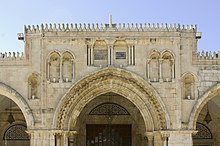
The facade of the mosque was built in 1065 CE on the instructions of the Fatimid caliph al-Mustansir Billah. It was crowned with a balustrade consisting of arcades and small columns. The Crusaders damaged the facade, but it was restored and renovated by the Ayyubids. One addition was the covering of the facade with tiles.[74] The second-hand material of the facade's arches includes sculpted, ornamental material taken from Crusader structures in Jerusalem.[117] The facade consists of fourteen stone arches,[118][dubious – discuss] most of which are of a Romanesque style. The outer arches added by the Mamluks follow the same general design. The entrance to the mosque is through the facade's central arch.[119]
Interior
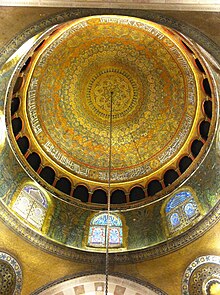
The al-Aqsa Mosque has seven aisles of hypostyle naves with several additional small halls to the west and east of the southern section of the building.[120] There are 121 stained glass windows in the mosque from the Abbasid and Fatimid eras. About a fourth of them were restored in 1924.[83] The spandrels of the arch opposite the main entrance include a mosaic decoration and inscription dating back to Fatimid period.[121]
The mosque's interior is supported by 45 columns, 33 of which are white marble and 12 of stone.[122] The column rows of the central aisles are heavy and stunted. The remaining four rows are better proportioned. The capitals of the columns are of four different kinds: those in the central aisle are heavy and primitively designed, while those under the dome are of the Corinthian order,[122] and made from Italian white marble. The capitals in the eastern aisle are of a heavy basket-shaped design and those east and west of the dome are also basket-shaped, but smaller and better proportioned. The columns and piers are connected by an architectural rave, which consists of beams of roughly squared timber enclosed in a wooden casing.[122]
A great portion of the mosque is covered with whitewash, but the drum of the dome and the walls immediately beneath it are decorated with mosaics and marble. Some paintings by an Italian artist were introduced when repairs were undertaken at the mosque after an earthquake ravaged the mosque in 1927.[122] The ceiling of the mosque was painted with funding by King Farouk of Egypt.[119]
Minbar
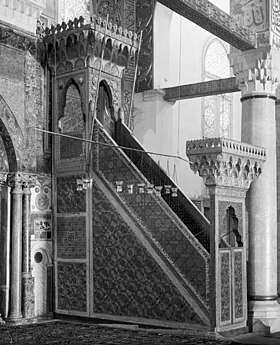
The minbar of the mosque was built by a craftsman named Akhtarini from Aleppo on the orders of the Zengid sultan Nur ad-Din. It was intended to be a gift for the mosque when Nur ad-Din would capture Jerusalem from the Crusaders and took six years to build (1168–74). Nur ad-Din died and the Crusaders still controlled Jerusalem, but in 1187, Saladin captured the city and the minbar was installed. The structure was made of ivory and carefully crafted wood. Arabic calligraphy, geometrical and floral designs were inscribed in the woodwork.[123]
After its destruction by Rohan in 1969, it was replaced by a much simpler minbar. In January 2007, Adnan al-Husayni—head of the Islamic waqf in charge of al-Aqsa—stated that a new minbar would be installed;[124] it was installed in February 2007.[125] The design of the new minbar was drawn by Jamil Badran based on an exact replica of the Saladin Minbar and was finished by Badran within a period of five years.[123] The minbar itself was built in Jordan over a period of four years and the craftsmen used "ancient woodworking methods, joining the pieces with pegs instead of nails, but employed computer images to design the pulpit [minbar]."[124]
Al-Marwani Mosque
The Marwani Mosque is another Islamic prayer hall situated in a large vaulted space beneath the main level of the southeastern corner of the compound, but still above the bedrock and within the enclosing walls of the Temple Mount. It is colloquially known as Solomon's Stables.[126]
The mosque consists of three hallways, the first of which acts as the main entrance, the second hallway which serves as the prayer hall with room for 4,000 worshippers, and a third which is closed off with stone.[127] The whole structure is supported by 16 stone columns and is the largest roofed space within the Al-Aqsa Mosque compound.[127] The Jerusalem Islamic Waqf acquired a permit to use Solomon's Stables in 1996 as an alternative place of worship for occasional rainy days of the holy month of Ramadan.[128]
Other domed structures
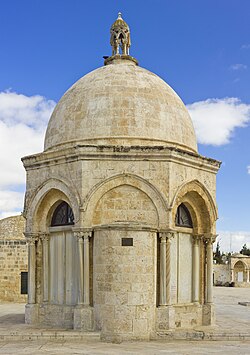
Dome of the Ascension
The Dome of the Ascension is a free-standing domed structure built by the Umayyads that stands just north the Dome of the Rock that commemorates the Islamic Prophet Muhammad's ascension (al-Miʿrāj) to heaven, according to Islamic tradition.[129]
The original edifice was probably built by either the Umayyads or the Abbasids (sometime between 7th-10th centuries),[129] while the current edifice was built by the Ayyubid governor of Jerusalem, Izz ad-Din az-Zanjili,[130] in 1200 or 1201 (during Sultan Al-Adil I's reign the brother of Saladin Al-Ayyubi[131]). An Arabic inscription dated to 1200 or 1201 (597 AH) describes it as renovated[109][132] and rededicated as a waqf.[133][134]
The dome did not exist in the Crusader era, as it was not described by Crusader travelers during their visit to the mosque during the Crusader occupation period, and there was no mention of the presence of a dome west of the Dome of the Rock.[135] The Ayyubid inscription talks about rebuilding a dome after its disappearance, guided by the information found in history books,[131] with the use of some Crusader materials.[129][136][131]
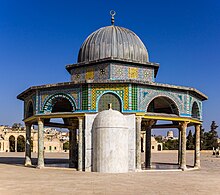
Dome of the Chain
The Dome of the Chain is a free-standing domed structure located adjacently east of the Dome of the Rock, and its exact historical use and significance are a matter of scholarly debate, but historical sources indicate it was built under the reign of Abd al-Malik, the same Umayyad caliph who built the Dome of the Rock.[137] Erected in 691–92 CE,[138] the Dome of the Chain is one of the oldest surviving structures at the al-Aqsa Mosque compound.[139]
It was built by the Umayyads, became a Christian chapel under the Crusaders, before being restored as an Islamic prayer house by the Ayyubids. It was then renovated by the Mamluks, Ottomans and the Jordanian-based waqf.
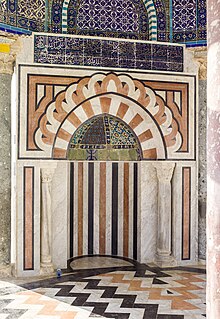
The building consists of a domed structure with two concentric open arcades, with no lateral walls closing it in. The dome, resting on a hexagonal drum, is made of timber and is supported by six columns which together create the inner arcade. The second, outer row of eleven columns creates an eleven-sided outer arcade. The qibla wall contains the mihrab or prayer niche and is flanked by two smaller columns.[138] There are a total of seventeen columns in the structure, excluding the mihrab.[140]
The columns and capitals used in the structure date to pre-Islamic times.[138] The Umayyad design of the building has largely remained unaltered by later restorations.[138]
The dome stands at the geometric centre of the esplanade which houses the al-Aqsa compound, the Haram, at the spot where the two central axes meet.[139][141] The central axes connect the centres of the opposing sides, and the Dome is also aligned on the long (approximately north-south) axis with what is presumed to be the oldest mihrab of the al-Aqsa Mosque.[141] This mihrab stands inside the 'Mosque of Omar', i.e. the southeastern section of the al-Aqsa Mosque, which corresponds by tradition to the earliest mosque built on the Temple Mount.[141] The "mihrab of Omar" as seen today stands exactly in the middle of the qibla wall of the Temple Mount.[141][142] It has been speculated that once the Dome of the Rock was built, the location of the main mihrab inside al-Aqsa Mosque has been repositioned on an axis with the centre of the Dome of the Rock, as it is until today, but the old position is preserved by the separate mihrab of the 'Mosque of Omar'.[141]
In Islamic tradition the Dome of the Chain marks the place where in the "end of days" the Last Judgment will take place, with a chain allowing passage only to the just and stopping all the sinful.[139]
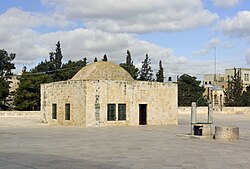
Dome of al-Khalili
The Dome of al-Khalili is a small domed-building located north of the Dome of the Rock. The Dome of al-Khalili was built in the early 18th century during Ottoman rule of Palestine in dedication to Shaykh Muhammad al-Khalili, a scholar of fiqh who died in 1734.[143][144]
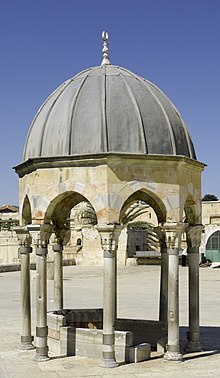
Dome of the Prophet
The Dome of the Prophet is a free-standing dome located on the northwest part of the elevated platform where the Dome of the Rock stands near the Dome of the Ascension.[145]
Originally, built during the Umayyad period, the dome was subsequently destroyed by the Crusaders, and rebuilt in 1539 by Muhammad Bek, Ottoman Governor of Jerusalem during the regin of Suleiman the Magnificent.[146][147] Its last renovation was in the reign of Sultan Abdul al-Majid II.[citation needed]
Several Muslim writers, most notably al-Suyuti and al-Vâsıtî claimed that the site of the dome is where Muhammad led the former prophets and angels in prayer on the night of Isra and Mir'aj before ascending to Heaven.[148][145][149][150][151] Endowment documents from the Ottoman period indicate that a portion of the endowment of the al-Aqsa Mosque and Haseki Sultan Imaret [152] was dedicated to maintain the lighting of an oil-lamp in the Dome of the Prophet each night.[153][148]
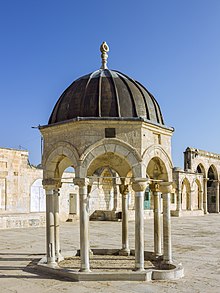
Dome of the Spirits
The Dome of the Spirits, or possibly "Dome of the Winds", is a small dome that stands to the north of the Dome of the Rock and is dated to the 16th century.[154][109] It could be associated with the proximity of the Well of Souls, where, according to legend, the souls of the dead will be gathered for prayer on the day of judgment.[citation needed]
It was probably built during Umayyad period because Ibn al-Faqih al-Hamadani (3-4H/9-10th century) in his Mukhtasar Kitab al-Buldan mentioned that there was a dome in al-Aqsa enclave called Kubbat Jibril (Dome of Gabriel). Then it was called Kubbat al-Ruh and Kubbat al-Arvah (Dome of the Spirits). It was probably then rebuilt during the 10th century AH/16th century AC during the Ottoman period.[155]
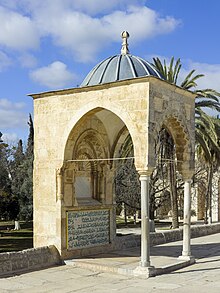
Dome of Yusuf
The Dome of Yusuf is a free-standing domed structure built by Saladin (born Yusuf) in the 12th century, and has been renovated several times.[156][157][158] It bears inscriptions from the 12th and 17th centuries: one dated 1191 in Saladin's name, and two mentioning Yusuf Agha, possibly a governor of Jerusalem or a eunuch in the Ottoman imperial palace.[156][159][160]

Dome of Yusuf Agha
The Dome of Yusuf Agha is a small square building in the courtyard between the Islamic Museum and al-Aqsa Mosque (al-Qibli).
It was built in 1681 and commemorates Yusuf Agha, who also endowed the Dome of Yusuf,[161][162] a smaller and more intricate-looking structure about 120 metres (390 ft) to the north. It was converted in the 1970s into a ticket office.[161][163]
Other examples
In the southwest corner of the upper platform is a quadrangular structure which includes a portion topped by another dome. It is known as the Dome of Literature (Qubba Nahwiyya in Arabic) and dated to 1208.[109] Standing further east, close to one of the southern entrance arcades, is a stone minbar known as the "Summer Pulpit" or Minbar of Burhan al-Din, used for open-air prayers. It appears to be an older ciborium from the Crusader period, as attested by its sculptural decoration, which was then reused under the Ayyubids. Sometime after 1345, a Mamluk judge named Burhan al-Din (d. 1388) restored it and added a stone staircase, giving it its present form.[164][165]
Minarets
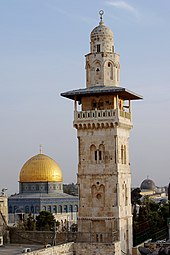
The mosque compound has four minarets, with three along the western perimeter of the esplanade and one along the northern wall. These are the Ghawanima Minaret, Bab al Silsila Minaret, Fakhriyya Minaret and Bab al-Asbat Minaret. The earliest dated minaret was constructed on the northwest corner of the Temple Mount in 1298, with three other minarets added over the course of the 14th century.[166][167]
Ghawanima Minaret
The Ghawanima Minaret or Al-Ghawanima Minaret was built at the northwestern corner of the Noble Sanctuary during the reign of Sultan Lajin circa 1298, or between 1297 and 1299,[166] or circa circa 1298.[167][168] It is named after Shaykh Ghanim ibn Ali ibn Husayn, who was appointed the Shaykh of the Salahiyyah Madrasah by Saladin.[169][unreliable source]
The minaret is located near the Ghawanima Gate and is the most decorated minaret of the compound.[170] It is 38.5 meters tall, with six stories and an internal staircase of 120 steps, making it the highest minaret inside the Al-Aqsa compound.[170][171] Its design may have been influenced by the Romanesque style of older Crusader buildings in the city.[168]
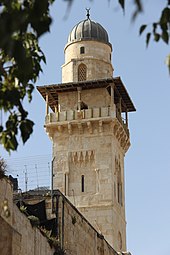
Bab al-Silsila Minaret (Minaret of the Chain Gate)
The Bab al-Silsila Minaret (Minaret of the Chain Gate) was built in 1329 by Tankiz, the Mamluk governor of Syria, near the Chain Gate, on the western border of the al-Aqsa Mosque.[172][173] The minaret is also known as Mahkamah Minaret since the minaret is located near the Madrasa al-Tankiziyya which served as a law court during the times of Ottomans.[174]
This minaret, possibly replacing an earlier Umayyad minaret, is built in the traditional Syrian square tower type and is made entirely out of stone.[175]
Since the 16th century, it has been a tradition that the best muezzin of the adhan (the call to prayer) is assigned to this minaret because the first call to each of the five daily prayers is raised from it, giving the signal for the muezzins of mosques throughout Jerusalem to follow suit.[176][full citation needed]
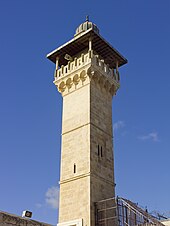
Fakhriyya Minaret
The Fakhriyya Minaret[177][178] or Al-Fakhiriyya Minaret,[179] was built on the junction of the southern wall and western wall,[180] over the solid part of the wall.[181] The exact date of its original construction is not known but it was built sometime after 1345 and before 1496.[177][182] It was named after Fakhr al-Din al-Khalili, the father of Sharif al-Din Abd al-Rahman who supervised the building's construction.[citation needed] The minaret was rebuilt in 1920.[183][verification needed][full citation needed]
The Fakhriyya Minaret was built in the traditional Syrian style, with a square-shaped base and shaft, divided by moldings into three floors above which two lines of muqarnas decorate the muezzin's balcony. The niche is surrounded by a square chamber that ends in a lead-covered stone dome.[184][full citation needed] After the minaret was damaged in the Jerusalem earthquake, the minaret's dome was covered with lead.[183]
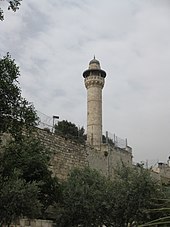
Bab al-Asbat Minaret (Minaret of the Tribes' Gate)
The last and most notable minaret was built in 1367: the Bāb al-ʾAsbāṭ Minaret, near the Tribes' Gate (al-ʾAsbāṭ Gate). It is composed of a cylindrical stone shaft (built later by the Ottomans), which springs up from a rectangular Mamluk-built base on top of a triangular transition zone.[185] The shaft narrows above the muezzin's balcony and is dotted with circular windows, ending with a bulbous dome.[185]
The dome was reconstructed after the 1927 earthquake.[185] It was then reconstructed after the 1967 Arab-Israeli War, when the minaret was bombed, causing severe damage and requiring a comprehensive restoration, as most of the minaret was damaged by the strike. The cone was also covered with lead at this time.[186]
Other features
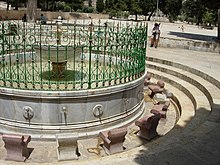
The main compound enclosure also houses an ablution fountain (known as al-Kas), originally supplied with water via a long narrow aqueduct leading from the so-called Solomon's Pools near Bethlehem, but now supplied from Jerusalem's water mains.
Gardens take up the eastern and most of the northern side of the enclosure, with an Islamic school occupying a small part of the space.[187]
Northern and western porticos
The complex is bordered on the south and east by the outer walls of the Old City of Jerusalem. On the north and west it is bordered by two long porticos (riwaq), built during the Mamluk period.[188] A number of other structures were also built along these areas, mainly also from the Mamluk period. On the north side, they include the Isardiyya Madrasa, built sometime before 1345, and the Almalikiyya Madrasa, dated to 1340.[189] On the west side, they include the Ashrafiyya Madrasa, built by Sultan Qaytbay between 1480 and 1482,[190] and the adjacent Uthmaniyya Madrasa, dated to 1437.[191] The Sabil of Qaytbay, contemporary with the Ashrafiyya Madrasa, also stands nearby.[190]
Gates
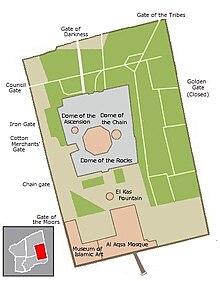
There are currently eleven open gates offering access to the Muslim Haram al-Sharif.
- Bab al-Asbat (Gate of the Tribes); north-east corner
- Bab al-Hitta/Huttah (Gate of Remission, Pardon, or Absolution); northern wall
- Bab al-Atim/'Atm/Attim (Gate of Darkness); northern wall
- Bab al-Ghawanima (Gate of Bani Ghanim); north-west corner
- Bab al-Majlis / an-Nazir/Nadhir (Council Gate / Inspector's Gate); western wall (northern third)
- Bab al-Hadid (Iron Gate); western wall (central part)
- Bab al-Qattanin (Gate of the Cotton Merchants); western wall (central part)
- Bab al-Matarah/Mathara ( Ablution Gate); western wall (central part)
- Two twin gates follow south of the Ablution Gate, the Tranquility Gate and the Gate of the Chain:
- Bab as-Salam / al-Sakina (Tranquility Gate / Gate of the Dwelling), the northern one of the two; western wall (central part)
- Bab as-Silsileh (Gate of the Chain), the southern one of the two; western wall (central part)
- Bab al-Magharbeh/Maghariba (Moroccans' Gate/Gate of the Moors; see Maghrebis); western wall (southern third); the only entrance for non-Muslims
A twelfth gate still open during Ottoman rule is now closed to the public:
- Bab as-Sarai (Gate of the Seraglio); a small gate to the former residence of the Pasha of Jerusalem; western wall, northern part (between the Bani Ghanim and Council gates).
Current situation
Administration
The administrative body responsible for the whole Al-Aqsa Mosque compound is known as "the Jerusalem Waqf", an organ of the Jordanian government.[192][193]
The Jerusalem Waqf is responsible for administrative matters in the Al-Aqsa Mosque compound. Religious authority on the site, on the other hand, is the responsibility of the Grand Mufti of Jerusalem, appointed by the government of the State of Palestine.[194]
After the 1969 arson attack, the waqf employed architects, technicians and craftsmen in a committee that carry out regular maintenance operations. The Islamic Movement in Israel and the waqf have attempted to increase Muslim control of the Temple Mount as a way of countering Israeli policies and the escalating presence of Israeli security forces around the site since the Second Intifada. Some activities included refurbishing abandoned structures and renovating.[195]
Ownership of the al-Aqsa Mosque is a contentious issue in the Israel-Palestinian conflict. During the negotiations at the 2000 Camp David Summit, Palestinians demanded complete ownership of the mosque and other Islamic holy sites in East Jerusalem.[196]
Access
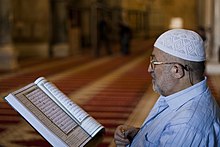
Muslims who are residents of Israel or visiting the country and Palestinians living in East Jerusalem are normally allowed to enter the Temple Mount and pray at al-Aqsa Mosque without restrictions.[197] Due to security measures, the Israeli government occasionally prevents certain groups of Muslims from reaching al-Aqsa by blocking the entrances to the complex; the restrictions vary from time to time. At times, restrictions have prevented all men under 50 and women under 45 from entering, but married men over 45 are allowed. Sometimes the restrictions are enforced on the occasion of Friday prayers,[198][199] other times they are over an extended period of time.[198][200][201] Restrictions are most severe for Gazans, followed by restrictions on those from West Bank. The Israeli government states that the restrictions are in place for security reasons.[197]
Until 2000, non-Muslim visitors could enter the Al-Aqsa Mosque by getting a ticket from the Waqf. That procedure ended when the Second Intifada began. Over two decades later, the Waqf still hopes negotiations between Israel and Jordan may result in allowing visitors to enter once again.[202]
Conflicts
In April 2021, during both Passover and Ramadan, the site was a focus of tension between Israeli settlers and Palestinians. Jewish settlers broke an agreement between Israel and Jordan and performed prayers and read from the Torah inside the Al-Aqsa compound, an area normally off limits for prayer to non-Muslims.[203] On 14 April, Israeli police entered the Al-Aqsa compound and forcibly cut wires to speakers in minarets around the mosque, silencing the call to prayer, claiming the sound was interfering with an event by the Israeli president at the Western Wall.[204] On 16 April, seventy thousand Muslims prayed in the Al-Aqsa compound, the largest gathering since the beginning of the COVID pandemic; police barred most from entering the Al-Aqsa mosque.[205] In May 2021, hundreds of Palestinians were injured following clashes in the Al-Aqsa compound after reports of Israel's intention to proceed to evict Palestinians from land claimed by Israeli settlers.[206][207]
On 15 April 2022, Israeli forces entered the Al-Aqsa compound and used tear gas shells and sound bombs to disperse Palestinians who, they said, were throwing stones at policemen. Some Palestinians barricaded themselves inside the Al-Aqsa mosque, where they were detained by Israeli police. Over 150 people ended up injured and 400 arrested.[208][209][210]
On 5 April 2023, Israeli police raided Al-Aqsa, saying "agitators" who had thrown stones and fired fireworks at the police, had barricaded themselves and worshippers inside Al-Aqsa mosque. Following the incident, militants fired rockets from Gaza into southern Israel.[211]
On 14 April 2024, during a wave of Iranian strikes in Israel, Israel intercepted missiles and drones over Al-Aqsa. In response, Iranian supreme leader Ali Khamenei tweeted in Hebrew, 'Al-Quds will be in the hands of the Muslims,' and posted footage showing the Iranian missiles being intercepted by Israeli defenses above the Dome of the Rock.[212][213]
In popular culture
The term "al-Aqsa" as a symbol and brand-name has become popular and prevalent in the region.[18] For example, the Al-Aqsa Intifada (the uprising that broke out in September 2000), the al-Aqsa Martyrs' Brigades (a coalition of Palestinian nationalist militias in the West Bank), al-Aqsa TV (the official Hamas-run television channel), al-Aqsa University (Palestinian university established in 1991 in the Gaza Strip), Jund al-Aqsa (a Salafist jihadist organization that was active during the Syrian Civil War), the Jordanian military periodical published since the early 1970s, and the associations of both the southern and northern branches of the Islamic Movement in Israel are all named Al-Aqsa after this site.[18]
The popular political slogan Al-Aqsa is in danger has been used to oppose efforts such as the Temple Mount Faithful's to take control of the compound, as well as to oppose archaeological investigations perceived as either undermining the structural foundations of the area or attempting to prove the existence of an ancient Jewish temple on the site.[214][215][216]
See also
- Islam in Israel
- Islam in the Palestinian territories
- Islamization of Palestine
- Islamization of Jerusalem – Religious transformation of Jerusalem to adopt Islamic influences since the 7th century
- Islamization of the Temple Mount – Islamic religious complex atop the Temple Mount in Jerusalem
- Islamization of Jerusalem – Religious transformation of Jerusalem to adopt Islamic influences since the 7th century
- Al-Juʽranah in Saudi Arabia, alternative location for Quranic "al-Aqsa mosque"
- List of the oldest mosques in the world
- Mosque of Omar (Jerusalem) – Mosque in the Christian Quarter of Jerusalem
- Palestinian nationalism – Movement for self-determination and sovereignty of Palestine
- Religious significance of the Syrian region – Region east of the Mediterranean Sea
- Status Quo (Jerusalem and Bethlehem) – Understanding among religious communities
- Temple denial – Historical assertion
Notes
- ^ K. A. C. Creswell, the archaeologists Robert Hamilton and Henri Stern, and the historian F. E. Peters attribute the original Umayyad construction to al-Walid.[32][33] Other architectural historians, Julian Rabi,[34] Jere Bacharach,[35] and Yildirim Yavuz,[30] as well as the scholars H. I. Bell,[36] Rafi Grafman and Myriam Rosen-Ayalon,[37] and Amikam Elad,[38] assert or suggest that Abd al-Malik started the project and al-Walid finished or expanded it.
- ^ This tradition is detailed in the work of the 15th-century Jerusalemite historian Mujir al-Din, the 15th-century historian al-Suyuti and the 11th-century Jerusalemite writers al-Wasiti and Ibn al-Murajja. The tradition cites an isnad (chain of transmission) traced to Thabit, a mid-8th-century attendant of the sanctuary complex, who transmits on the authority of Raja ibn Haywa, Abd al-Malik's court theologian who supervised the financing of the Dome of the Rock's construction.[39]
- ^ The 10th-century historians Eutychius of Alexandria and al-Muhallabi attribute the mosque's construction to al-Walid, though they also erroneously credit him for the Dome of the Rock's construction. Other inaccuracies in their works make Elad question their reliability on the matter. A number of 13th-century historians, including Ibn al-Athir, support the claim, but Elad points out that they copy directly from the 10th-century historian al-Tabari, whose work only mentions al-Walid building the great mosques of Damascus and Medina, with the 13th-century historians adding the al-Aqsa Mosque to his roster of great building works. Traditions by sources based in nearby Ramla in the mid-8th century similarly credit al-Walid for the mosques in Damascus and Medina, but limit his role in Jerusalem to providing food for the city's Quran reciters.[44]
- ^ A great famine during the reign of al-Ma'mun depleted the Muslim population, and the situation was exacerbated for all of the city's inhabitants during the city's plunder by the peasant rebels of al-Mubarqa.[58] The situation may have recovered by the late 10th century, but the unprecedented depredations throughout Palestine by the Bedouins of the Banu Tayy under the Jarrahids in the 1020s likely caused a substantial decrease in the population.[59]
- ^ This description of al-Zahir's mosque is the general scholarly view and is based on archaeological studies carried out during restoration work in the 1920s and the diary of Nasir Khusraw's visit in 1047.[60]
- ^ The inscription above the central mihrab reads
In the name of God, the Compassionate, the Merciful, Glory to the One who took his servant for a journey by night from the masjid al-haram to the masjid al-aqsa whose precincts we have blessed. [… He] has renovated it, our lord Ali Abu al-Hasan the imam al-Zahir li-i'zaz Din Allah, Commander of the Faithful, son of al-Hakim bi-Amr Allah, Commander of the Faithful, may the blessing of God be on him and his pure ancestors, and on his noble descendants [Shia religious formula alluding to the descendants of Muhammad through his daughter Fatima and her husband Ali, Muhammad's cousin]. By the hand of Ali ibn Abd al-Rahman, may God reward him. The [job] was supervised by Abu al-Wasim and al-Sharif al-Hasan al-Husaini.[63]
- ^ The Fatimid efforts to strengthen the Muslim position in Jerusalem, starting from the reign of al-Zahir's predecessor, Caliph al-Hakim, was part of a proxy religious conflict between them and the Christian Byzantine Empire. From at least the 9th century, efforts had been underway to boost the city's Christian edifices, such as the Holy Sepulchre, and pilgrimage infrastructure by Christian powers and leaders, including the Carolingian Empire and the patriarch of Jerusalem, in the backdrop of renewed Byzantine offensive action against Islamic Syria. Recurrences of mob violence by the city's Muslims against Christians are reported in the 10th century, a time in which al-Muqaddasi laments that Christians and Jews in Jerusalem held the upper hand against the Muslims.[67] The Fatimid inscription also points to al-Zahir's reassertion of the orthodox Muslim narrative of the Night Journey and Muhammad's primacy in Islam against the claims by the Druze, a newly emergent outgrowth of Isma'ili Islam in Egypt and Syria, of al-Hakim's divinity and occultation.[68]
References
Citations
- ^ Al-Ratrout, H. A., The Architectural Development of Al-Aqsa Mosque in the Early Islamic Period, ALMI Press, London, 2004.
- ^ a b Williams, George (1849). The Holy City: Historical, Topographical and Antiquarian Notices of Jerusalem. Parker. pp. 143–160. Archived from the original on 19 July 2023. Retrieved 22 June 2022.
The following detailed account of the Haram es-Sherif, with some interesting notices of the City, is extracted from an Arabic work entitled " The Sublime Companion to the History of Jerusalem and Hebron, by Kadi Mejir-ed-din, Ebil-yemen Abd-er-Rahman, El-Alemi," who died A. H. 927, (A. d. 1521)… "I have at the commencement called attention to the fact that the place now called by the name Aksa (i. e. the most distant), is the Mosk [Jamia] properly so called, at the southern extremity of the area, where is the Minbar and the great Mihrab. But in fact Aksa is the name of the whole area enclosed within the walls, the dimensions of which I have just given, for the Mosk proper [Jamia], the Dome of the Rock, the Cloisters, and other buildings, are all of late construction, and Mesjid el-Aksa is the correct name of the whole area."
and also von Hammer-Purgstall, J.F. (1811). "Chapitre vingtième. Description de la mosquée Mesdjid-ol-aksa, telle qu'elle est de nos jours, (du temps de l'auteur, au dixième siècle de l'Hégire, au seizième après J. C.)". Fundgruben des Orients (in French). Vol. 2. Gedruckt bey A. Schmid. p. 93. Archived from the original on 19 July 2023. Retrieved 22 June 2022.Nous avons dès le commencement appelé l'attention sur que l'endroit, auquel les hommes donnent aujourd'hui le nom d'Aksa, c'est à-dire, la plus éloignée, est la mosquée proprement dite, bâtie à l'extrêmité méridionale de l'enceinte où se trouve la chaire et le grand autel. Mais en effet Aksa est le nom de l'enceinte entière, en tant qu'elle est enfermée de murs, dont nous venons de donner la longueur et la largeur, car la mosquée proprement dite, le dôme de la roche Sakhra, les portiques et les autres bâtimens, sont tous des constructions récentes, et Mesdjidol-aksa est le véritable nom de toute l'enceinte. (Le Mesdjid des arabes répond à l'ίερόν et le Djami au ναός des grecs.)
- ^
- Tucker, S.C.; Roberts, P. (2008). The Encyclopedia of the Arab-Israeli Conflict: A Political, Social, and Military History [4 volumes]: A Political, Social, and Military History. ABC-CLIO history reference online. ABC-CLIO. p. 70. ISBN 978-1-85109-842-2. Archived from the original on 19 July 2023. Retrieved 19 June 2022.
Al-Aqsa Mosque The al-Aqsa Mosque (literally, "farthest mosque") is both a building and a complex of religious buildings in Jerusalem. It is known to Muslims as al-Haram al-Sharif (the Noble Sanctuary) and to Jews and Christians as the Har ha-Bayit or Temple Mount. The whole area of the Noble Sanctuary is considered by Muslims to be the al-Aqsa Mosque, and the entire precinct is inviolable according to Islamic law. It is considered specifically part of the waqf (endowment) land that had included the Western Wall (Wailing Wall), property of an Algerian family, and more generally a waqf of all of Islam. When viewed as a complex of buildings, the al-Aqsa Mosque is dominated and bounded by two major structures: the al-Aqsa Mosque building on the east and the Dome of the Rock (or the Mosque of Omar) on the west. The Dome of the Rock is the oldest holy building in Islam.
- "Jerusalem holy site clashes fuel fears of return to war". BBC News. 2022-04-22. Archived from the original on 24 May 2022. Retrieved 30 May 2022.
Whole site also considered by Muslims as Al Aqsa Mosque
- UNESCO World Heritage Centre (2022-04-04). "39 COM 7A.27 - Decision". UNESCO World Heritage Centre. Archived from the original on 30 May 2022. Retrieved 2022-05-29.
…the historic Gates and windows of the Qibli Mosque inside Al-Aqsa Mosque/ Al-Haram Al-Sharif, which is a Muslim holy site of worship and an integral part of a World Heritage Site
- The Survey of Western Palestine, Jerusalem, 1884, p.119: "The Jamia el Aksa, or 'distant mosque' (that is, distant from Mecca), is on the south, reaching to the outer wall. The whole enclosure of the Haram is called by Moslem writers Masjid el Aksa, 'praying-place of the Aksa,' from this mosque."
- Yitzhak Reiter: "This article deals with the employment of religious symbols for national identities and national narratives by using the sacred compound in Jerusalem (The Temple Mount/al-Aqsa) as a case study. The narrative of The Holy Land involves three concentric circles, each encompassing the other, with each side having its own names for each circle. These are: Palestine/Eretz Israel (i.e., the Land of Israel); Jerusalem/al-Quds and finally The Temple Mount/al-Aqsa compound...Within the struggle over public awareness of Jerusalem's importance, one particular site is at the eye of the storm—the Temple Mount and its Western Wall—the Jewish Kotel—or, in Muslim terminology, the al-Aqsa compound (alternatively: al-Haram al-Sharif) including the al-Buraq Wall... "Al-Aqsa" for the Palestinian-Arab-Muslim side is not merely a mosque mentioned in the Quran within the context of the Prophet Muhammad's miraculous Night Journey to al-Aqsa which, according to tradition, concluded with his ascension to heaven (and prayer with all of the prophets and the Jewish and Christian religious figures who preceded him); rather, it also constitutes a unique symbol of identity, one around which various political objectives may be formulated, plans of action drawn up and masses mobilized for their realization", "Narratives of Jerusalem and its Sacred Compound" Archived 21 May 2022 at the Wayback Machine, Israel Studies 18(2):115-132 (July 2013)
- Annika Björkdahl and Susanne Buckley-Zistel: "The site is known in Arabic as Haram al-Sharif – the Noble Sanctuary – and colloquially as the Haram or the al-Aqsa compound; while in Hebrew, it is called Har HaBeit – the Temple Mount." Annika Björkdahl; Susanne Buckley-Zistel (1 May 2016). Spatialising Peace and Conflict: Mapping the Production of Places, Sites and Scales of Violence. Palgrave Macmillan UK. pp. 243–. ISBN 978-1-137-55048-4. Archived from the original on 21 May 2022. Retrieved 21 May 2022.
- Mahdi Abdul Hadi:"Al-Aqsa Mosque, also referred to as Al-Haram Ash-Sharif (the Noble Sanctuary), comprises the entire area within the compound walls (a total area of 144,000 m2) - including all the mosques, prayer rooms, buildings, platforms and open courtyards located above or under the grounds - and exceeds 200 historical monuments pertaining to various Islamic eras. According to Islamic creed and jurisprudence, all these buildings and courtyards enjoy the same degree of sacredness since they are built on Al-Aqsa's holy grounds. This sacredness is not exclusive to the physical structures allocated for prayer, like the Dome of the Rock or Al-Qibly Mosque (the mosque with the large silver dome)"Mahdi Abdul Hadi Archived 2020-02-16 at the Wayback Machine Palestinian Academic Society for the Study of International Affairs; Tim Marshall: "Many people believe that the mosque depicted is called the Al-Aqsa; however, a visit to one of Palestine's most eminent intellectuals, Mahdi F. Abdul Hadi, clarified the issue. Hadi is chairman of the Palestinian Academic Society for the Study of International Affairs, based in East Jerusalem. His offices are a treasure trove of old photographs, documents, and symbols. He was kind enough to spend several hours with me. He spread out maps of Jerusalem's Old City on a huge desk and homed in on the Al-Aqsa compound, which sits above the Western Wall. "The mosque in the Al-Aqsa [Brigades] flag is the Dome of the Rock. Everyone takes it for granted that it is the Al-Aqsa mosque, but no, the whole compound is Al-Aqsa, and on it are two mosques, the Qibla mosque and the Dome of the Rock, and on the flags of both Al-Aqsa Brigades and the Qassam Brigades, it is the Dome of the Rock shown," he said. Tim Marshall (4 July 2017). A Flag Worth Dying For: The Power and Politics of National Symbols. Simon and Schuster. pp. 151–. ISBN 978-1-5011-6833-8. Archived from the original on 12 September 2019. Retrieved 17 April 2018.*Hughes, Aaron W. (2014). Theorizing Islam: Disciplinary Deconstruction and Reconstruction. Religion in Culture. Taylor & Francis. p. 45. ISBN 978-1-317-54594-1. Archived from the original on 19 July 2023. Retrieved 24 June 2022.
Although later commentators would debate whether or not this journey was a physical one or took place at an internal level, it would come to play a crucial role in establishing Muhammad's prophetic credentials. In the first part of this journey, referred to as the isra, he traveled from the Kaba in Mecca to "the farthest mosque" (al-masjid al-aqsa), identified with the Temple Mount in Jerusalem: the al-Aqsa mosque that stands there today eventually took its name from this larger precinct, in which it was constructed.
*Sway, Mustafa A. (2015), "Al-Aqsa Mosque: Do Not Intrude!", Palestine - Israel Journal of Politics, Economics, and Culture, 20/21 (4): 108–113, ProQuest 1724483297, archived from the original on 19 July 2023, retrieved 28 July 2022 – via ProQuest,Ahmed ibn Hanbal (780–855): "Verily, 'Al-Aqsa' is a name for the whole mosque which is surrounded by the wall, the length and width of which are mentioned here, for the building that exists in the southern part of the Mosque, and the other ones such as the Dome of the Rock and the corridors and other [buildings] are novel (muhdatha)." Mustafa Sway: More than 500 years ago, when Mujir Al-Din Al-Hanbali offered the above definition of Al-Aqsa Mosque in the year 900 AH/1495, there were no conflicts, no occupation and no contesting narratives surrounding the site.
*Omar, Abdallah Marouf (2017). "Al-Aqsa Mosque's Incident in July 2017: Affirming the Policy of Deterrence". Insight Turkey. 19 (3): 69–82. doi:10.25253/99.2017193.05. JSTOR 26300531.In a treaty signed by Jordan and the Palestinian Authority on March 31, 2013, both sides define al-Aqsa Mosque as being "al-Masjid al-Aqsa with its 144 dunums, which include the Qibli Mosque of al-Aqsa, the Mosque of the Dome of the Rock, and all its mosques, buildings, walls, courtyards". ... Israel insists on identifying al-Aqsa Mosque as being a small building. ... Nonetheless, the Executive Board of UNESCO adopted the Jordanian definition of al-Aqsa Mosque in its Resolution (199 EX/PX/DR.19.1 Rev).
*Occupied Palestine: draft decision (199 EX/PX/DR.19.1 REV), UNESCO Executive Board. UNESCO. 2016.
- Tucker, S.C.; Roberts, P. (2008). The Encyclopedia of the Arab-Israeli Conflict: A Political, Social, and Military History [4 volumes]: A Political, Social, and Military History. ABC-CLIO history reference online. ABC-CLIO. p. 70. ISBN 978-1-85109-842-2. Archived from the original on 19 July 2023. Retrieved 19 June 2022.
- ^ The Archaeology of the Holy Land: From the Destruction of Solomon's Temple to the Muslim Conquest Archived 15 July 2020 at the Wayback Machine, Cambridge University Press, Jodi Magness, page 355
- ^ a b c Robinson, E.; Smith, E. (1841). Biblical Researches in Palestine. John Murray.
The Jámi'a el-Aksa is the mosk alone; the Mesjid el-Aksa is the mosk with all the sacred enclosure and precincts, including the Sükhrah. Thus the words Mesjid and Jāmi'a differ in usage somewhat like the Greek ίερόν and ναός.
- ^ a b c Palmer, E. H. (1871). "History of the Haram Es Sherif: Compiled from the Arabic Historians". Palestine Exploration Quarterly. 3 (3): 122–132. doi:10.1179/peq.1871.012. ISSN 0031-0328.
EXCURSUS ON THE NAME MASJID EL AKSA. In order to understand the native accounts of the sacred area at Jerusalem, it is essentially necessary to keep in mind the proper application of the various names by which it is spoken of. When the Masjid el Aksa is mentioned, that name is usually supposed to refer to the well-known mosque on the south side of the Haram, but such is not really the case. The latter building is called El Jámʻi el Aksa, or simply El Aksa, and the substructures are called El Aksa el Kadímeh (the ancient Aksa), while the title El Masjid el Aksa is applied to the whole sanctuary. The word Jámi is exactly equivalent in sense to the Greek συναγωγή, and is applied to the church or building in which the worshippers congregate. Masjid, on the other hand, is a much more general term; it is derived from the verb sejada "to adore," and is applied to any spot, the sacred character of which would especially incite the visitor to an act of devotion. Our word mosque is a corruption of masjid, but it is usually misapplied, as the building is never so designated, although the whole area on which it stands may be so spoken of. The Cubbet es Sakhrah, El Aksa, Jam'i el Magharibeh, &c., are each called a Jami, but the entire Haram is a masjid. This will explain how it is that 'Omar, after visiting the churches of the Anastasis, Sion, &c., was taken to the "Masjid" of Jerusalem, and will account for the statement of Ibn el 'Asa'kir and others, that the Masjid el Aksa measured over 600 cubits in length-that is, the length of the whole Haram area. The name Masjid el Aksa is borrowed from the passage in the Coran (xvii. 1), when allusion is made to the pretended ascent of Mohammed into heaven from ·the temple of Jerusalem; "Praise be unto Him who transported His servant by night from El Masjid el Haram (i.e., 'the Sacred place of Adoration' at Mecca) to El Masjid el Aksa (i.e., 'the Remote place of Adoration' at Jerusalem), the precincts of which we have blessed," &c. The title El Aksa, "the Remote," according to the Mohammedan doctors, is applied to the temple of Jerusalem "either because of its distance from Mecca, or because it is in the centre of the earth."
- ^ a b Warren, Charles; Conder, Claude Reignier (1884). The survey of Western Palestine. Jerusalem. Published for the Committee of the Palestine Exploration Fund. London. p. 119 – via Internet Archive.
{{cite book}}: CS1 maint: location missing publisher (link) - ^ a b c Le Strange, Guy (1890). Palestine Under the Moslems: A Description of Syria and the Holy Land from A.D. 650 to 1500. Translated from the Works of the Medieval Arab Geographers. Houghton, Mifflin. p. 96. Archived from the original on 19 July 2023. Retrieved 31 July 2022.
Great confusion is introduced into the Arab descriptions of the Noble Sanctuary by the indiscriminate use of the terms Al Masjid or Al Masjid al Akså, Jami' or Jami al Aksâ; and nothing but an intimate acquaintance with the locality described will prevent a translator, ever and again, misunderstanding the text he has before him-since the native authorities use the technical terms in an extraordinarily inexact manner, often confounding the whole, and its part, under the single denomination of "Masjid." Further, the usage of various writers differs considerably on these points : Mukaddasi invariably speaks of the whole Haram Area as Al Masjid, or as Al Masjid al Aksî, "the Akså Mosque," or "the mosque," while the Main-building of the mosque, at the south end of the Haram Area, which we generally term the Aksa, he refers to as Al Mughattâ, "the Covered-part." Thus he writes "the mosque is entered by thirteen gates," meaning the gates of the Haram Area. So also "on the right of the court," means along the west wall of the Haram Area; "on the left side" means the east wall; and "at the back" denotes the northern boundary wall of the Haram Area. Nasir-i-Khusrau, who wrote in Persian, uses for the Main-building of the Aksâ Mosque the Persian word Pushish, that is, "Covered part," which exactly translates the Arabic Al Mughatta. On some occasions, however, the Akså Mosque (as we call it) is spoken of by Näsir as the Maksurah, a term used especially to denote the railed-off oratory of the Sultan, facing the Mihrâb, and hence in an extended sense applied to the building which includes the same. The great Court of the Haram Area, Nâsir always speaks of as the Masjid, or the Masjid al Akså, or again as the Friday Mosque (Masjid-i-Jum'ah).
- ^ Idrīsī, Muhammad; Jaubert, Pierre Amédée (1836). Géographie d'Édrisi (in French). à l'Imprimerie royale. pp. 343–344. Archived from the original on 19 July 2023. Retrieved 31 July 2022.
Sous la domination musulmane il fut agrandi, et c'est (aujourd'hui) la grande mosquée connue par les Musulmans sous le nom de Mesdjid el-Acsa مسجد الأقصى. Il n'en existe pas au monde qui l'égale en grandeur, si l'on en excepte toutefois la grande mosquée de Cordoue en Andalousie; car, d'après ce qu'on rapporte, le toit de cette mosquée est plus grand que celui de la Mesdjid el-Acsa. Au surplus, l'aire de cette dernière forme un parallelogramme dont la hauteur est de deux cents brasses (ba'a), et le base de cents quatre-vingts. La moitié de cet espace, celle qui est voisin du Mihrab, est couverte d'un toit (ou plutôt d'un dôme) en pierres soutenu par plusieurs rangs de colonnes; l'autre est à ciel ouvert. Au centre de l'édifice est un grand dôme connu sous le nom de Dôme de la roche; il fut orné d'arabesques en or et d'autres beaux ouvrages, par les soins de divers califes musulmans. Le dôme est percé de quatre portes; en face de celle qui est à l'occident, on voit l'autel sur lequel les enfants d'Israël offraient leurs sacrifices; auprès de la porte orientale est l'église nommée le saint des saints, d'une construction élégante; au midi est une chapelle qui était à l'usage des Musulmans; mais les chrétiens s'en sont emparés de vive force et elle est restée en leur pouvoir jusqu'à l'époque de la composition du présent ouvrage. Ils ont converti cette chapelle en un couvent où résident des religieux de l'ordre des templiers, c'est-à-dire des serviteurs de la maison de Dieu.
Also at Williams, G.; Willis, R. (1849). "Account of Jerusalem during the Frank Occupation, extracted from the Universal Geography of Edrisi. Climate III. sect. 5. Translated by P. Amédée Jaubert. Tome 1. pp. 341—345.". The Holy City: Historical, Topographical, and Antiquarian Notices of Jerusalem. J.W. Parker. Archived from the original on 19 July 2023. Retrieved 31 July 2022. - ^ Mustafa Abu Sway (Fall 2000). "The Holy Land, Jerusalem and Al-Aqsa Mosque in the Islamic Sources". Journal of the Central Conference of American Rabbis (CCAR): 60–68. Archived from the original on 29 May 2022. Retrieved 29 May 2022.
Quoting Mujir al-Din: "Verily, 'Al-Aqsa' is a name for the whole mosque which is surrounded by the wall, the length and width of which are mentioned here, for the building that exists in the southern part of the Mosque, and the other ones such as the Dome of the Rock and the corridors and other [buildings] are novel"
- ^ Le Strange, Guy (1890). Palestine Under the Moslems: A Description of Syria and the Holy Land from A.D. 650 to 1500. Translated from the Works of the Medieval Arab Geographers. Houghton, Mifflin. Archived from the original on 19 July 2023. Retrieved 29 May 2022.
THE AKSÀ MOSQUE. The great mosque of Jerusalem, Al Masjid al Aksà, the "Further Mosque," derives its name from the traditional Night Journey of Muhammad, to which allusion is made in the words of the Kuran (xvii. I)... the term "Mosque" being here taken to denote the whole area of the Noble Sanctuary, and not the Main-building of the Aksà only, which, in the Prophet's days, did not exist.
- ^ Strange, Guy le (1887). "Description of the Noble Sanctuary at Jerusalem in 1470 A.D., by Kamâl (or Shams) ad Dîn as Suyûtî". Journal of the Royal Asiatic Society of Great Britain and Ireland. 19 (2). Royal Asiatic Society of Great Britain and Ireland: 247–305. doi:10.1017/S0035869X00019420. ISSN 0035-869X. JSTOR 25208864. S2CID 163050043.
…the term Masjid (whence, through the Spanish Mezquita, our word Mosque) denotes the whole of the sacred edifice, comprising the main building and the court, with its lateral arcades and minor chapels. The earliest specimen of the Arab mosque consisted of an open courtyard, within which, round its four walls, run colonades or cloisters to give shelter to the worshippers. On the side of the court towards the Kiblah (in the direction of Mekka), and facing which the worshipper must stand, the colonade, instead of being single, is, for the convenience of the increased numbers of the congregation, widened out to form the Jami' or place of assembly… coming now to the Noble Sanctuary at Jerusalem, we must remember that the term 'Masjid' belongs not only to the Aksa mosque (more properly the Jami' or place of assembly for prayer), but to the whole enclosure with the Dome of the Rock in the middle, and all the other minor domes and chapels.
- ^ St Laurent, B., & Awwad, I. (2013). The Marwani Musalla in Jerusalem: New Findings. Jerusalem Quarterly.
- ^ Jarrar, Sabri (1998). "Suq al-Ma'rifa: An Ayyubid Hanbalite Shrine in Haram al-Sharif". In Necipoğlu, Gülru (ed.). Muqarnas: An Annual on the Visual Culture of the Islamic World (Illustrated, annotated ed.). Brill. p. 85. ISBN 978-90-04-11084-7.
"Al-Masjid al-Aqsa" was the standard designation for the whole sanctuary until the Ottoman period, when it was superseded by "al-Haram al-Sharif"; "al-Jami' al-Aqsa" specifically referred to the Aqsa Mosque, the mughatta or the covered aisles, the site on which 'Umar founded the first mosque amidst ancient ruins.
- ^ Grabar, Oleg (2000). "The Haram al-Sharif: An Essay in Interpretation" (PDF). Bulletin of the Royal Institute for Inter-Faith Studies. Constructing the Study of Islamic Art. 2 (2). Archived from the original (PDF) on 2016-04-14.
It is only at a relatively late date that the Muslim holy space in Jerusalem came to be referred to as al-haram al-sharif (literally, the Noble Sacred Precinct or Restricted Enclosure, often translated as the Noble Sanctuary and usually simply referred to as the Haram). While the exact early history of this term is unclear, we know that it only became common in Ottoman times, when administrative order was established over all matters pertaining to the organization of the Muslim faith and the supervision of the holy places, for which the Ottomans took financial and architectural responsibility. Before the Ottomans, the space was usually called al-masjid al-aqsa (the Farthest Mosque), a term now reserved to the covered congregational space on the Haram, or masjid bayt al-maqdis (Mosque of the Holy City) or, even, like Mecca's sanctuary, al-masjid al-ḥarâm.
- ^ Schick, Robert (2009). "Geographical Terminology in Mujir al-Din's History of Jerusalem". In Khalid El-Awaisi (ed.). Geographical Dimensions of Islamic Jerusalem. Cambridge Scholars Publisher. pp. 91–106. ISBN 978-1-4438-0834-7.
Mujir al-Din defined al-Masjid al-Aqsā as the entire compound, acknowledging that in common usage it referred to the roofed building at the south end of the compound. As he put it (1999 v.2, 45; 1973 v.2, 11), the jami' that is in the core of al-Masjid al-Aqsa at the qiblah where the Friday service takes place is known among the people as "al-Masjid al-Aqsa", and (1999 v.2, 63-64; 1973 v.2, 24) what is known among the people as "al-Aqsa" is the jami in the core of the masjid in the direction of the giblah, where the minbar and the large mihrab are. The truth of the matter is that the term "al-Aqsa" is for all of the masjid and what the enclosure walls surround. What is intended by "al-Masjid al-Aqsā" is everything that the enclosure walls surround. Mujir al-Din did not identify al-Masjid al-Aqsā by the alternative term "al-Haram al-Sharif". That term began to be used in the Mamluk period and came into more general use in the Ottoman period. He only used the term when giving the official title of the government-appointed inspector of the two noble harams of Jerusalem and Hebron (Nazir al-Haramavn al-Sharifayn). While Mujir al-Din did not explicitly discuss why the masjid of Bayt al-Magdis "is not called the haram" (1999 v.1, 70; 1973 v.1, 7), he may well have adopted the same position as Ibn Taymiyah, his fellow Hanbali in the early 14th century (Ziyarat Bayt al-Maqdis Matthews 1936, 13; Iqtida' al-Sirat al-Mustaqim Mukhalafat Ashab al-Jahim Memon 1976: 316) in rejecting the idea that al-Masjid al-Aqsa (or the tomb of Abraham in Hebron) can legitimately be called a haram, because there are only three harams (where God prohibited hunting): Makkah, Madinah, and perhaps Täif. However Mujir al-Din was not fully consistent and also used al-Masiid al-Aqsã to refer to the roofed building, as for example when he referred to al-Nasir Muhammad installing marble in al-Masjid al-Aqsà (1999 v.2, 161; 1973 v.2, 92); he used the term al-Jami al-Aqsa in the parallel passage (1999 v.2, 396; 1973 v.2, 271)
- ^ Wazeri, Yehia Hassan (2014-02-20). "The Farthest Mosque or the Alleged Temple an Analytic Study". Journal of Islamic Architecture. 2 (3). Maulana Malik Ibrahim State Islamic University. doi:10.18860/jia.v2i3.2462. ISSN 2356-4644. S2CID 190588084.
Many people think that Al-Masjid Al-Aqsa is only the mosque established south of the Dome of the Rock, where the obligatory five daily prayers are performed now. Actually, Al-Masjid Al-Aqsa is a term that applies to all parts of the Masjid, including the area encompassed within the wall, such as the gates, the spacious yards, the mosque itself, the Dome of the Rock, Al-Musalla Al-Marawani, the corridors, domes, terraces, free drinking water (springs), and other landmarks, like minarets on the walls. Furthermore, the whole mosque is unroofed with the exception of the building of the Dome of the Rock and Al-Musalla Al-Jami`, which is known by the public as Al-Masjid Al-Aqsa. The remaining area, however, is a yard of the mosque. This is agreed upon by scholars and historians, and accordingly, the doubled reward for performing prayer therein is attained if the prayer is performed in any part of the area encompassed by the wall. Indeed, Al-Masjid Al-Aqsa, which is mentioned in Almighty Allah's Glorious Book in the first verse of Sura Al-Isra' is the blessed place that is now called the Noble Sanctuary (Al-Haram Al-Qudsi Ash-Sharif) which is enclosed within the great fence and what is built over it. Moreover, what applies to the mosque applies by corollary to the wall encircling it, since it is part of it. Such is the legal definition of Al-Masjid Al-Aqsa. Regarding the concept (definition) of Al-Masjid Al-Aqsa, Shaykh `Abdul-Hamid Al-Sa'ih, former Minister of (Religious) Endowments and Islamic Sanctuaries in Jordan said: "The term Al-Masjid Al-Aqsa, for the Muslim public, denotes all that is encircled by the wall of Al-Masjid Al-Aqsa, including the gates". Therefore, (the legally defined) Al-Masjid Al-Aqsa and Al-Haram Al-Qudsi Ash-Sharif (the Noble Sanctuary) are two names for the same place, knowing that Al-Haram Ash-Sharif is a name that has only been coined recently.
- ^ a b c d Reiter, Yitzhak (2008). Jerusalem and Its Role in Islamic Solidarity. Palgrave Macmillan US. pp. 21–23. ISBN 978-0-230-61271-6.
During the Middle Ages, when the issue of Jerusalem's status was a point of controversy, the supporters of Jerusalem's importance (apparently after its liberation from Crusader control) succeeded in attributing to al-Quds or to Bayt-al-Maqdis (the Arabic names for Jerusalem) the status of haram that had been accorded to the sacred compound. The site was thus called al-Haram al-Sharif, or al-Haram al-Qudsi al-Sharif. Haram, from an Arabic root meaning "prohibition," is a place characterized by a particularly high level of sanctity – a protected place in which blood may not be shed, trees may not be felled, and animals may not be hunted. The status of haram was given in the past to the Sacred Mosque in Mecca and to the Mosque of the Prophet in al-Madina (and some also accorded this status to the Valley of Wajj in Ta'if on the Arabian Peninsula?). Thus, al-Masjid al-Aqsa became al-Haram al-Sharif (the Noble Sanctuary) in order to emphasize its exalted status alongside the two other Muslim sanctuaries. Although, as noted before, Ibn-Taymiyya refuted the haram status of the Jerusalem mosque, al-Aqsa's upgrading to haram status was successful and has prevailed. It became a commonly accepted idea and one referred to in international forums and documents. It was, therefore, surprising that during the 1980s the Palestinians gradually abandoned the name that had been given to the Haram/Temple Mount compound in apparent honor of Jerusalem's status as third in sanctity – al-Haram al-Sharif – in favor of its more traditional name-al-Aqsa. An examination of relevant religious texts clarifies the situation: since the name al-Aqsa appears in the Quran, all Muslims around the world should be familiar with it; thus it is easier to market the al-Aqsa brand-name. An additional factor leading to a return to the Qur'anic name is an Israeli demand to establish a Jewish prayer space inside the open court of the compound. The increased use of the name al-Aqsa is particularly striking against the background of what is written on the Web site of the Jerusalem Waqf, under the leadership of (former) Palestinian mufti Sheikh Ikrima Sabri. There it is asserted that "al Masjid al-Aqsa was erroneously called by the name al-Haram al-Qudsi al-Sharif," and that the site's correct name is al-Aqsa. This statement was written in the context of a fatwa in response to a question addressed to the Web site's scholars regarding the correct interpretation of the Isra' verse in the Quran (17:1), which tells of the Prophet Muhammad's miraculous Night Journey from the "Sacred Mosque to the Farthest Mosque" – al-Aqsa. In proof of this, Sabri quotes Ibn-Taymiyya, who denied the existence of haram in Jerusalem, a claim that actually serves those seeking to undermine the city's sacred status. Sabri also states that Arab historians such as Mujir al-Din al-Hanbali, author of the famed fifteenth-century work on Jerusalem, do not make use of the term "haram" in connection with the al-Aqsa site. Both Ibn-Taymiyya and Mujir al-Din were affiliated with the Hanbali School of law-the relatively more puritan stream in Islam that prevailed in Saudi Arabia. The Hanbalies rejected innovations, such as the idea of a third haram. One cannot exclude the possibility that the Saudis, who during the 1980s and 1990s donated significant funds to Islamic institutions in Jerusalem, exerted pressure on Palestinian-Muslim figures to abandon the term "haram" in favor of "al-Aqsa". The "al-Aqsa" brand-name has thus become popular and prevalent. Al-Haram al-Sharif is still used by official bodies (the Organization of the Islamic Conference [OIC], the Arab League), in contrast to religious entities. The public currently uses the two names interchangeably. During the last generation, increasing use has been made of the term "al-Aqsa" as a symbol and as the name of various institutions and organizations. Thus, for example, the Jordanian military periodical that has been published since the early 1970s is called al-Aqsa; the Palestinian police unit established by the PA in Jericho is called the Al-Aqsa Division; the Fatah's armed organization is called the Al-Aqsa Brigades; the Palestinian Police camp in Jericho is called the Al-Aqsa Camp; the Web sites of the southern and northern branches of the Islamic movement in Israel and the associations that they have established are called al-Aqsa; the Intifada that broke out in September 2000 is called the al-Aqsa Intifada and the Arab summit that was held in the wake of the Intifada's outbreak was called the al-Aqsa Summit. These are only a few examples of a growing phenomenon.
- ^ a b Dan Bahat (1990). The Illustrated Atlas of Jerusalem. Simon & Schuster. pp. 81–82.
- ^ Andreas Kaplony (2009). "635/638–1099: The Mosque of Jerusalem (Masjid Bayt al-Maqdis)". In Oleg Grabar and Benjamin Z. Kedar (ed.). Where Heaven and Earth Meet: Jerusalem's Sacred Esplanade. Yad Ben-Zvi Press. pp. 100–131.
- ^ a b c F. E. Peters (1985). Jerusalem. Princeton University Press. pp. 186–192. ISBN 978-0-691-07300-2.
- ^ Yehoshua Frenkel, 'Jerusalem', in Abdelwahab Meddeb, Benjamin Stora (eds.), A History of Jewish-Muslim Relations: From the Origins to the Present Day, Princeton University Press, 2013 p.108.
- ^ John Wilkinson (2002). Jerusalem Pilgrims before the Crusades. p. 170.
- ^ The Dome of the Rock as Palimpsest, Necipoglu, Muqarnas 2008
- ^ Matthew Gordon (2005). The Rise of Islam. Greenwood Publishing Group. p. 44. ISBN 978-0-313-32522-9. Retrieved 3 October 2010.
- ^ Mahdī ʻAbd al-Hādī; PASSIA. (2007). Documents on Jerusalem. PASSIA, Palestinian Academic Society for the Study of International Affairs. p. 247. ISBN 978-9950-305-19-9. Retrieved 3 October 2010.
The Islamization of the Temple Mount culminated at the end of the seventh century, with the establishment of the Dome of the Rock above the Foundation Stone and the construction of the al-Aqsa mosque in the south of the Temple Mount.
- ^ Oleg Grabar, The Haram ak-Sharif: An essay in interpretation, BRIIFS vol. 2 no 2 (Autumn 2000) Archived 2012-10-04 at the Wayback Machine
- ^ a b Elad 1999, pp. 31–32.
- ^ a b c Grabar 1986, p. 340.
- ^ a b c d Yavuz 1996, p. 153.
- ^ Elad 1999, p. 33.
- ^ Allan 1991, p. 16.
- ^ Elad 1999, p. 36, note 58.
- ^ Allan 1991, pp. 16–17.
- ^ Bacharach 1996, p. 30.
- ^ a b Bell 1908, p. 116.
- ^ Grafman & Rosen-Ayalon 1999, p. 2.
- ^ a b Elad 1999, p. 39.
- ^ a b Elad 1999, p. 36.
- ^ a b c d e Grabar 1986, p. 341.
- ^ Le Strange 1890a, pp. 90–91.
- ^ Elad 1999, pp. 36–37.
- ^ Elad 1999, pp. 26, 36–37.
- ^ Elad 1999, pp. 37–38.
- ^ Grafman & Rosen-Ayalon 1999, p. 6.
- ^ a b Goitein 1986, p. 326.
- ^ a b Pruitt 2017, p. 36.
- ^ a b Pruitt 2017, pp. 36–37.
- ^ a b c d e f Grabar 1991, p. 707.
- ^ Pruitt 2017, p. 37.
- ^ Jeffers 2004, pp. 95–96.
- ^ Le Strange 1890a, pp. 98–99.
- ^ Pruitt 2017, pp. 37–38.
- ^ Pruitt 2017, pp. 36, 38.
- ^ Le Strange 1890a, pp. 94, 98–99.
- ^ Pruitt 2017, p. 41.
- ^ a b Grabar 1986, p. 342.
- ^ Goitein 1986, pp. 326–327.
- ^ Goitein 1986, pp. 328–329.
- ^ a b c d Pruitt 2017, p. 45.
- ^ a b Grabar 1991, pp. 707–708.
- ^ Pruitt 2017, pp. 45–46.
- ^ a b c Pruitt 2017, p. 46.
- ^ Pruitt 2017, p. 47.
- ^ a b Le Strange 1888, pp. 36–37.
- ^ Pruitt 2017, p. 44.
- ^ Pruitt 2017, pp. 39–43.
- ^ Pruitt 2017, pp. 50–51.
- ^ Pruitt 2017, pp. 44–45.
- ^ Goitein 1986, p. 328.
- ^ Pringle, 1993, p. 403.
- ^ a b Boas, 2001, p. 91.
- ^ Selwood, Dominic. "Birth of the Order". Archived from the original on 17 December 2013. Retrieved 20 April 2013.
- ^ a b c d e Ma'oz, Moshe and Nusseibeh, Sari. (2000). Jerusalem: Points of Friction, and Beyond BRILL. pp. 136–138. ISBN 90-411-8843-6.
- ^ The History Channel, Decoding the Past: The Templar Code, 7 November 2005, video documentary written by Marcy Marzuni.
- ^ Barber, The New Knighthood, p. 7.
- ^ Hancock, Lee. Saladin and the Kingdom of Jerusalem: the Muslims recapture the Holy Land in AD 1187 Archived 12 September 2019 at the Wayback Machine. 2004: The Rosen Publishing Group. ISBN 0-8239-4217-1
- ^ Madden, 2002, p. 230.
- ^ Hava Lazarus-Yafeh (1 December 1981). Some religious aspects of Islam: a collection of articles. Brill Archive. p. 69. ISBN 978-90-04-06329-7. Retrieved 3 October 2010.
In the same way, when Jerusalem was taken back under the leadership of Saladin in 1187, and particularly from the 13th-century and on, a great deal of building activity began around the Temple Mount and in the whole city — obviously so as to establish its Islamic character.
- ^ a b Al-Aqsa Guide Archived 6 October 2008 at the Wayback Machine Friends of Al-Aqsa 2007.
- ^ Pappe, Ilan (2012). "Chapter 2: In the Shadow of Acre and Cairo: The Third Generation". The Rise and Fall of a Palestinian Dynasty: The Huyaynis 1700 – 1948. Saqi Books. ISBN 978-0-86356-801-5. Archived from the original on 15 July 2020. Retrieved 14 August 2015.
- ^ a b "Hashemite Restorations of the Islamic Holy Places in Jerusalem" Archived 2008-02-23 at the Wayback Machine, Jordanian government website.
- ^ a b Yuvaz, 1996, pp. 149–153.
- ^ Fr Alexander Lucie-Smith, Jerusalem's archives: a tantalising glimpse of a lost world, Catholic Herald, 29 August 2019. Accessed 14 June 2023.
- ^ Hamilton (1949), pp. 1–2 Archived 26 October 2020 at the Wayback Machine
- ^ a b Baruch et al. (2018). pp. 13-14.
- ^ a b c Michelina Di Cesare (2020). "The mosaic pavement beneath the floor of al-Aqṣā mosque: A case study of late antique artistic koiné". In Fabio Guidetti and Katharina Meinecke (ed.). A Globalised Visual Culture?. Oxbow. pp. 289–320.
- ^ Sachar, Howard M. (2013). A History of Israel: From the Rise of Zionism to Our Time (2nd ed.). Knopf Doubleday Publishing Group. ISBN 978-0-8041-5049-1. Retrieved 2016-03-20.
- ^ Fischer, N. (2019), "Religious Ritual, Injustice, and Resistance: Praying Politically in Israel/Palestine", in Moyaert, Marianne (ed.), Interreligious Relations and the Negotiation of Ritual Boundaries, Palgrave Macmillan, pp. 61–82, doi:10.1007/978-3-030-05701-5_4, ISBN 978-3-030-05700-8, S2CID 201363247
- ^ "The Burning of Al-Aqsa". Time. 29 August 1969. p. 1. Archived from the original on 28 June 2011. Retrieved 1 July 2008.
- ^ "Madman at the Mosque". Time. 12 January 1970. Archived from the original on 30 October 2010. Retrieved 3 July 2008.
- ^ Esposito, 1998, p. 164.
- ^ a b c Al-Aqsa Mosque Restoration Archived 3 January 2009 at the Wayback Machine Archnet Digital Library.
- ^ Dumper, 2002, p. 44.
- ^ Sprinzak 2001, pp. 198–199.
- ^ a b c Contested holiness: Jewish, Muslim, and Christian perspectives on the Temple Mount in Jerusalem, Rivka Gonen, KTAV Publishing House, Inc., 2003, p.. 167-8.
- ^ "Remnants of the Temple?," Danny Rubinstein, September 12, 2004.
- ^ Hershel Shanks (14 October 2007). Jerusalem's Temple Mount: from Solomon to the golden Dome. Continuum. p. 76. ISBN 9780826428844. Retrieved 3 October 2010.
In recent years Solomon's Stables have been in the news. The story is part of the larger story of the recent Islamization of the Temple Mount.
- ^ "Israel, Jordan said holding talks to end conflict at Temple Mount gate". Times of Israel. 6 March 2019. Retrieved 21 March 2021.
- ^ "Provocative' mosque visit sparks riots". BBC News. BBC MMVIII. 28 September 2000. Archived from the original on 29 January 2019. Retrieved 1 July 2008.
- ^ Khaled Abu Toameh. "How the war began". Archived from the original on 28 March 2006. Retrieved 29 March 2006.
- ^ "In a Ruined Country". The Atlantic Monthly Online. September 2005. Archived from the original on 30 August 2008. Retrieved 5 March 2017.
- ^ "Israeli occupation forces breach Al-Aqsa Mosque for the first time since 1967". Middle East Monitor. Archived from the original on 23 December 2014. Retrieved 23 December 2014.
- ^ Prawer, P.M.H.J.; Prawer, J.; Ben-Shammai, H.; Yad Yitsḥaḳ Ben-Tsevi; Universiṭah ha-ʻIvrit bi-Yerushalayim (1996). The History of Jerusalem: The Early Muslim Period (638–1099). NYU Press. p. 81. ISBN 978-0-8147-6639-2. Retrieved 2022-05-31.
... The Temple Mount, al-Haram al-Sharif, is a large esplanade (sahn in Arabic) ...
- ^ National Geographic Society (U.S.); de Blij, H.J.; Downs, R.; John Wiley & Sons (2007). Wiley/National Geographic College Atlas of the World. Wiley. p. 49. ISBN 978-0-471-74117-6. Retrieved 2022-06-15.
Al 'Aqsa is the second oldest mosque in Islam after the Kaaba in Mecca and is third in holiness after the mosques in Mecca and Medina. It holds up to 400,000 worshippers at one time.
- ^ Ahmed, A.S.; Sonn, T. (2010). The SAGE Handbook of Islamic Studies. SAGE Publications. p. 229. ISBN 978-1-4739-7168-4.
Questions of visual domination and conversion were among the important factors in the construction of the oldest surviving Islamic monument, the Dome of the Rock in Jerusalem.
- ^ George, A. (2010). The Rise of Islamic Calligraphy. Saqi. p. 60. ISBN 978-0-86356-673-8.
The answer to this question begins with the oldest surviving Islamic monument : the Dome of the Rock
- ^ a b Avner, Rina (2010). "The Dome of the Rock in light of the development of concentric martyria in Jerusalem" (PDF). Muqarnas. Vol. 27: An Annual on the Visual Cultures of the Islamic World. Leiden: Brill. pp. 31–50 [43–44]. ISBN 978-900418511-1. JSTOR 25769691. Archived from the original (PDF) on 25 March 2017. Retrieved 24 March 2017.
- ^ a b c d Murphy-O'Connor, Jerome (2008). The Holy Land: An Oxford Archaeological Guide from Earliest Times to 1700. Oxford University Press. p. 98. ISBN 978-0-19-923666-4.
- ^ "Drawings of Islamic Buildings: Dome of the Rock, Jerusalem". Victoria and Albert Museum. Archived from the original on 9 March 2009.
Until 1833 the Dome of the Rock had not been measured or drawn; according to Victor von Hagen, 'no architect had ever sketched its architecture, no antiquarian had traced its interior design...' On 13 November in that year, however, Frederick Catherwood dressed up as an Egyptian officer and accompanied by an Egyptian servant 'of great courage and assurance', entered the buildings of the mosque with his drawing materials... 'During six weeks, I continued to investigate every part of the mosque and its precincts.' Thus, Catherwood made the first complete survey of the Dome of the Rock, and paved the way for many other artists in subsequent years, such as William Harvey, Ernest Richmond and Carl Friedrich Heinrich Werner.
- ^ a b c "Dome of the Rock". Encyclopædia Britannica. Archived from the original on 15 June 2008. Retrieved 4 April 2012.
- ^ The Dome of the Rock[usurped]. Glass Steel and Stone.
- ^ Robert Schick, Archaeology and the Quran, Encyclopaedia of the Qur'an
- ^ a b c "Qubba al-Sakhra". ArchNet. Archived from the original on 14 August 2019. Retrieved 8 April 2020.
- ^ Gonzalez-Quijano, Yves (2010-09-01). "Jérusalem, capitale " éternelle et indivisible " de la culture arabe?". Méditerranée (114): 131–133. doi:10.4000/mediterranee.4488. ISSN 0025-8296.
- ^ Necipogulu, 1998, p. 14.
- ^ Hillenbrand, Carolle. (2000). The Crusades: The Islamic Perspective Archived 15 July 2020 at the Wayback Machine Routeledge, p. 382 ISBN 0-415-92914-8.
- ^ "Al-Aqsa Mosque, Jerusalem". Atlas Travel and Tourist Agency. Archived from the original on 26 July 2008. Retrieved 29 June 2008.
- ^ a b Al-Aqsa Mosque, Jerusalem Archived 24 July 2008 at the Wayback Machine Sacred Destinations.
- ^ Al-Aqsa Mosque Archived 3 January 2009 at the Wayback Machine Archnet Digital Library.
- ^ The Encyclopaedia of Islam; By H. A. R. Gibb, E. van Donzel, P. J. Bearman, J. van Lent; p.151
- ^ a b c d Al-Aqsa Mosque Archived 16 November 2016 at the Wayback Machine Life in the Holy Land.
- ^ a b Oweis, Fayeq S. (2002) The Elements of Unity in Islamic Art as Examined Through the Work of Jamal Badran Archived 15 July 2020 at the Wayback Machine Universal-Publishers, pp. 115–117. ISBN 1-58112-162-8.
- ^ a b Wilson, Ashleigh. Lost skills revived to replicate a medieval minbar Archived 14 April 2020 at the Wayback Machine. The Australian. 2008-11-11. Access date: 8 July 2011.
- ^ Mikdadi, Salwa D. Badrans: A Century of Tradition and Innovation, Palestinian Art Court Archived 4 January 2009 at the Wayback Machine Riweq Bienalle in Palestine.
- ^ "Photograph of King Solomon's Stables". Archived from the original on 2002-07-19. Retrieved 2018-04-05.
- ^ a b Ghosheh, M. Hashim. (2005). Guide to the Masjid al-Aqsa; an Architectural and Historical Guide to the Islamic Monuments in the Masjid al-Aqsa. Ministry of Awqaf and Religious Affairs.
- ^ Rivka Gonen (2003). Contested Holiness: Jewish, Muslim, and Christian Perspectives on the Temple Mount in Jerusalem. KTAV Publishing House, Inc. pp. 167–169. ISBN 978-0-88125-799-1.
- ^ a b c Abbasids, Originally Built by the Ummayads or the; Current Edifice Was Built By The Ayyubid Governor Of Jerusalem, Izz ad-Din az-Zanjili. "Temple Mount, Dome of Ascension / The Qubbat al-Miraj". JSTOR.
- ^ "Qubbat al-Miʿraj". Institute for International Urban Development (I2UD). Archived from the original on 2022-06-02. Retrieved 2023-08-09.
- ^ a b c Al-Jallad, I. (2017). معالم المسجد الأقصى تحت المجهر [Al-Aqsa Mosque landmarks under the microscope]. Baytul Maqdis Center for Literature.
- ^ Bahat, Dan (1996). Prawer, Joshua; Ben-Shammai, Haggai (eds.). The History of Jerusalem: The Early Muslim Period (638-1099). New York University Press. p. 86. ISBN 978-0-8147-6639-2.
- ^ Pawer, Jonathan (1996). The History of Jerusalem: The Early Muslim Period (638-1099). New York University Press. p. 86. ISBN 0814766390.
- ^ Simon Sebag Montefiore, Jerusalem: The Biography, p. 276.
- ^ وصف الأماكن المقدسة في فلسطين للرحالة الألماني ثيودريش [Description of the Holy Places in Palestine by the German traveler Theodoric] (S. Al-Bishawy & R. Shaheen, Trans.). (2003). Dar Al-Shorok for publication and distribution.
- ^ "Al-Aqsa Mosque al-Haram ash-Sharif" (PDF). TİKA. 2013. Archived (PDF) from the original on 2017-06-12.
- ^ Rosen-Ayalon, Myriam (1989). "The Early Islamic Monuments of Al-Ḥaram Al-Sharīf: An Iconographic Study". Qedem. 28: III–73. ISSN 0333-5844. JSTOR 43588798.
- ^ a b c d Pringle (1993), pp. 182–185
- ^ a b c Archnet: Qubba al-Silsila
- ^ Murphy-O'Connor (2008), p. 97
- ^ a b c d e Rosen-Ayalon (1989), pp. 25–29
- ^ Tillier (2018), pp. 341–365
- ^ Al-Aqsa Guide Archived October 6, 2008, at the Wayback Machine Al-Aqsa Friends 2007.
- ^ "Cloak belonging to Sheikh Muhammad al-Khalili". Discover Islamic Art. Museum With No Frontiers. Retrieved 2017-11-28.
- ^ a b Kaplony, Andreas (2002). The Ḥaram of Jerusalem (324-1099): Temple, Friday Mosque, Area of Spiritual Power. Zurich: Franz Steiner Verlag. p. 84. ISBN 978-3515079013.
- ^ Dome of the Prophet Archived 2019-12-18 at the Wayback Machine Noble Sanctuary Online Guide.
- ^ Aslan, Halide. "Osmanlı Döneminde Kudüs'teki İlmî Hayat". Journal of Islamic Research. 2015, 26(3):93-9: 94.
- ^ a b Uğurluel, Talha (2017). Arzın Kapısı Kudüs. Istanbul: Timaş. p. 289. ISBN 978-605-08-2425-4.
- ^ Le Strange, Guy (1890). Palestine Under The Moslems. pp. 123, 154, 155.
- ^ Armstrong, Karen. "Sacred Space: The Holiness of IslamicJerusalem". Journal of IslamicJerusalem Studies. 1 (1): 5–20.
- ^ Çalı, Erol (2018). Hüznün Başkenti Kudüs. İstanbul: Destek Yayınları. p. 249. ISBN 9786053113508.
- ^ Haseki Sultan Imaret
- ^ Al Masjidul Aqsa Site Plan Archived October 6, 2008, at the Wayback Machine Al-Aqsa Friends 2007.
- ^ Goldhill, Simon (2010). Jerusalem: City of Longing. Harvard University Press. p. 110. ISBN 978-0-674-26385-7.
- ^ Hadi, Mahdi Abdul (2013). "Al-Aqsa Mosque Al-Haram Ash-Sharif" (PDF). Palestinian Academic Society for the Study of International Affairs, PASSIA. (Supported by TİKA). Archived (PDF) from the original on 2017-06-12.
- ^ a b Carole Hillenbrand (2000). The Crusades: Islamic perspectives (Illustrated, reprint, annotated ed.). Routledge. p. 191. ISBN 978-0-415-92914-1.
a monumental inscription dated 587(AH)/1191 in [Saladin's] name on the Dome of Joseph [Qubbat Yusuf] on the Haram esplanade: 'the victorious king, the probity of this world and of [true] religion, the Sultan of Islam and of the Muslims, the servant of the two noble sanctuaries and of Jerusalem.'
- ^ Necipoğlu, Gülru (1998). Muqarnas: An Annual on the Visual Culture of the Islamic World (Illustrated, annotated ed.). BRILL. p. 73. ISBN 978-90-04-11084-7.
- ^ Myriam Rosen-Ayalon (2006). Islamic art and archaeology in Palestine (Illustrated ed.). Left Coast Press. p. 97. ISBN 978-1-59874-064-6.
- ^ [dead link] Qubbat Yusuf Archived August 5, 2011, at the Wayback Machine Archnet Digital Library.
- ^ [dead link] Al-Aqsa Guide Friends of al-Aqsa 2007. Archived December 20, 2008, at the Wayback Machine
- ^ a b "Qubbat Yusuf Agha". Institute for International Urban Development (I2UD). Archived from the original on 2022-04-25. Retrieved 2023-08-09.
- ^ Hillenbrand, Robert (2000). Auld, Sylvia (ed.). Ottoman Jerusalem. London: British School of Archaeology in Jerusalem. p. 16. ISBN 978-1-901435-03-0.
[…] two structures erected by Yusuf Agha in 1681 – the Qubbat Yusuf (an open-plan aedicule) and the Qubbat Yusuf Agha (a closed domed square) — clearly suggest that, despite the identical terminology, different forms connoted different functions in Jerusalem at that time.
- ^ Pilgrimage, Sciences and Sufism. Museum with No Frontiers. 2013. ISBN 978-3-902782-11-3.
the Haram al-Sharif is free, but an entrance fee is charged for visiting the Dome of the Rock, the Jami'a Al-Aqsa Mosque and the Islamic Museum. Tickets can be purchased with local currency from the kiosk outside the Islamic Museum
- ^ Burgoyne, Michael Hamilton (1987). Mamluk Jerusalem: An Architectural Study. British School of Archaeology in Jerusalem by the World of Islam Festival Trust. pp. 319–320. ISBN 978-0-905035-33-8.
- ^ Neci̇poğlu, Gülru (2008). "The Dome of the Rock as Palimpsest: ʻabd Al-Malik's Grand Narrative and Sultan Süleyman's Glosses". Muqarnas. 25: 17–105. doi:10.1163/22118993_02501004. ISSN 0732-2992. JSTOR 27811114.
- ^ a b Grabar, Oleg; Ḳedar, Benjamin Z. (2009). Where Heaven and Earth Meet: Jerusalem's Sacred Esplanade. University of Texas Press. p. 191. ISBN 978-0-292-72272-9.
- ^ a b Murphy-O'Connor, Jerome (2008). The Holy Land: An Oxford Archaeological Guide from Earliest Times to 1700. Oxford University Press. p. 90. ISBN 978-0-19-923666-4.
- ^ a b Cytryn-Silverman, K (2008). "Three Mamluk Minarets in Ramla". Jerusalem Studies in Arabic and Islam. 35: 379–432.
- ^ "Minarets". MasjidAlAqsa.net.
- ^ a b "Al-Aqsa Mosque al-Haram ash-Sharif" (PDF). TİKA. Archived from the original (PDF) on 2017-06-12. Retrieved 2023-07-25.
- ^ Brooke, Steven. Views of Jerusalem and the Holy Land. Rizzoli, 2003. ISBN 0-8478-2511-6
- ^ Burgoyne, Michael Hamilton; Richards, Donald Sidney (1987). Mamluk Jerusalem: An Architectural Study. British School of Archaeology in Jerusalem by the World of Islam Festival Trust. pp. 77, 244. ISBN 978-0-905035-33-8.
- ^ Galor, Katharina; Bloedhorn, Hanswulf (2013-11-26). The Archaeology of Jerusalem: From the Origins to the Ottomans. Yale University Press. p. 222. ISBN 978-0-300-11195-8.
- ^ Ghushah, M.H. (2005). Guide to the Masjid al-Aqsa. Ministry of Awqaf and Religious Affairs.
- ^ Bab al-Silsila Minaret Archived 2013-11-02 at the Wayback Machine Archnet Digital Library.
- ^ Jacobs, 2009, p.106.
- ^ a b Burgoyne, Michael Hamilton; Richards, Donald Sidney (1987). Mamluk Jerusalem: An Architectural Study. British School of Archaeology in Jerusalem by the World of Islam Festival Trust. p. 270. ISBN 978-0-905035-33-8.
- ^ Armstrong, Karen (2011). Jerusalem: One City, Three Faiths. Random House Publishing Group. p. 309. ISBN 978-0-307-79859-6.
- ^ Grabar, Oleg (2006). The Dome of the Rock. Harvard University Press. p. 9. ISBN 978-0-674-02313-0.
- ^ Patel, Ismail Adam (2006). Virtues of Jerusalem and islamic perspective. United Kingdom: al-Aqsa Publisher. p. 100.
- ^ Kapolony, Andreas (2010). The Ḥaram of Jerusalem (324-1099): Temple, Friday Mosque, Area of Spiritual Power. Freiburger Islamstudien. p. 281.
- ^ Kedar, Benjamin Z. (2017). "Vestiges of Templar presence in the Aqsa Mosque". In Borchardt, Karl; Döring, Karoline; Josserand, Philippe; Nicholson, Helen J. (eds.). The Templars and their Sources. Routledge. p. 21. ISBN 978-1-315-47527-1.
- ^ a b Passia (2013). "Mesjid Aksa Rehberi (Haram-i Serif)". TIKA: 3–66.
- ^ Menashe, 2004, p.334.
- ^ a b c Bab al-Asbat Minaret Archived 2011-06-29 at the Wayback Machine Archnet Digital Library.
- ^ Ghosheh, M. Hashim. (2005). Guide to the Masjid al-Aqsa; an Architectural and Historical Guide to the Islamic Monuments in the Masjid al-Aqsa. Ministry of Awqaf and Religious Affairs.
- ^ "Photograph of the northern wall area". Archived from the original on 2002-07-18. Retrieved 2018-04-05.
- ^ Mamluk Jerusalem: An Architectural Study, by MH Burgoyne and DS Richards, pages 104-107 (North Portico) and West Portico 192-194
- ^ Murphy-O'Connor, Jerome (2008). The Holy Land: An Oxford Archaeological Guide from Earliest Times to 1700. Oxford University Press. pp. 90–92. ISBN 978-0-19-923666-4.
- ^ a b Blair, Sheila S.; Bloom, Jonathan (1995). The Art and Architecture of Islam: 1250-1800. New Haven; London: Yale University Press. pp. 92–93.
- ^ Burgoyne, Michael Hamilton (1987). Mamluk Jerusalem: An Architectural Study. British School of Archaeology in Jerusalem by the World of Islam Festival Trust. pp. 544–547. ISBN 978-0-905035-33-8.
- ^ Jordan: We don't accept instructions from Israel on Temple Mount guards, Khaled Abu Toameh for The Jerusalem Post, 10 May 2022 (accessed the same day).
- ^ "Arab states neglect Al-Aqsa says head of Jerusalem Waqf". Al-Monitor. 5 September 2014. Archived from the original on 24 April 2016. Retrieved 5 April 2016.
- ^ Yaniv Berman, "Top Palestinian Muslim Cleric Okays Suicide Bombings" Archived 14 May 2013 at the Wayback Machine, Media Line, 23 October 2006.
- ^ Social Structure and Geography Palestinian Academic Society for the Study of International Affairs.
- ^ Camp David Projections Archived 11 January 2012 at the Wayback Machine Palestinian Academic Society for the Study of International Affairs. July 2000.
- ^ a b Mohammed Mar'i (14 August 2010). "Thousands barred from praying in Al-Aqsa". Arab News. Archived from the original on 18 November 2010.
- ^ a b "Fresh clashes mar al-Aqsa prayers". BBC News. 9 October 2009. Archived from the original on 2 October 2018. Retrieved 3 January 2011.
- ^ "Israel police, fearing unrest, limit al-Aqsa worship". i24news. 14 April 2014. Archived from the original on 10 August 2016.
- ^ "Israel boosts security in east Jerusalem". Archived from the original on 3 November 2018. Retrieved 3 January 2011.
- ^ Ramadan prayers at al-Aqsa mosque Archived 2 October 2018 at the Wayback Machine BBC News. 5 September 2008.
- ^ "Report: Israel, Jordan in Talks to Readmit non-Muslim Visitors to Temple Mount Sites". Haaretz. 30 June 2015. Archived from the original on 25 August 2015. Retrieved 11 September 2015.
- ^ Aseel Jundi (24 April 2021). "In Jerusalem, Ramadan sees heightened tensions at Al-Aqsa Mosque compound". Middle East Eye. Archived from the original on 25 April 2021. Retrieved 25 April 2021.
- ^ "Israel criticized for silencing call to prayer from Al-Aqsa Mosque". 16 April 2021. Archived from the original on 25 April 2021. Retrieved 2021-04-25.
- ^ Hamann, Jasper (16 April 2021). "Friday Prayers Draw 70,000 Palestinians to Al Aqsa Mosque". Archived from the original on 25 April 2021. Retrieved 2021-04-25.
- ^ "Scores injured in fresh night of Jerusalem clashes". The Guardian. 9 May 2021. Archived from the original on 9 May 2021. Retrieved 9 May 2021.
- ^ "Explainer: Jerusalem tense over evictions and holidays". Reuters. 10 May 2021. Archived from the original on 15 May 2021. Retrieved 15 May 2021.
- ^ Fabian, Emanuel; Boxerman, Aaron; staff, T. O. I. "Over 150 injured, 400 arrested as Palestinians clash with cops on Temple Mount". www.timesofisrael.com. Archived from the original on 6 May 2022. Retrieved 2022-04-15.
- ^ "Israeli forces raid Al-Aqsa Mosque, over 90 Palestinians injured". Al Jazeera. Archived from the original on 18 April 2022. Retrieved 15 April 2022.
- ^ "Al-Aqsa mosque: At least 90 injured as Israeli police clash with Palestinians". Sky News. Archived from the original on 18 April 2022. Retrieved 15 April 2022.
- ^ "Al-Aqsa mosque: Violence as Israeli police raid Jerusalem holy site". BBC. 5 April 2023. Retrieved 8 October 2023.
- ^ Tamari, Liran (2024-04-14). "Watch Iranian drones, missiles intercepted over Jerusalem, al Aqsa Mosque". Ynetnews. Retrieved 2024-04-14.
- ^ "'Al-Quds will be in the hands of the Muslims' - Ayatollah Khamenei tweets in Hebrew". The Jerusalem Post | JPost.com. 2024-04-14. Retrieved 2024-04-15.
- ^ Larkin, Craig; Dumper, Michael (2012). "In Defense of Al-Aqsa: The Islamic Movement inside Israel and the Battle for Jerusalem". Middle East Journal. 66 (1). Middle East Institute: 31–52. doi:10.3751/66.1.12. ISSN 0026-3141. JSTOR 41342768. S2CID 144916717. Retrieved 2023-08-01.
- ^ Reiter, Y. (2008). Jerusalem and Its Role in Islamic Solidarity. Palgrave Macmillan US. ISBN 978-0-230-61271-6. Retrieved 2023-08-01.
- ^ Center, Berkley; Affairs, World (2021-05-08). ""Al-Aqsa Is in Danger": How Jerusalem Connects Palestinian Citizens of Israel to the Palestinian Cause". Berkley Center for Religion, Peace and World Affairs. Retrieved 2023-08-01.
Sources
- Allan, J. W. (1991). "New Additions to the New Edition". Muqarnas. 8: 12–22. doi:10.2307/1523148. JSTOR 1523148.
- Bacharach, Jere L. (1996). "Marwanid Umayyad Building Activities: Speculations on Patronage". Muqarnas Online. 13: 27–44. doi:10.2307/1523250. JSTOR 1523250.
- Bell, H. I. (1908). "The Aphrodito Papyri". The Journal of Hellenic Studies. 28: 97–120. doi:10.2307/624559. JSTOR 624559. S2CID 164184450.
- Boas, Adrian (2001). Jerusalem in the Time of the Crusades: Society, Landscape and Art in the holy city under Frankish rule. Routledge. ISBN 0-415-23000-4. Archived from the original on 19 May 2021.
- Dumper, Michael (2002). The Politics of Sacred Space: The Old City of Jerusalem in the Middle East. Lynne Rienner Publishers. ISBN 1-58826-226-X. Archived from the original on 19 May 2021.
- Elad, Amikam (1999). Medieval Jerusalem and Islamic Worship: Holy Places, Ceremonies, Pilgrimage (2nd ed.). Leiden: Brill. ISBN 90-04-10010-5.
- Esposito, John L. (1998). Islam and Politics. Syracuse University Press. ISBN 0-8156-2774-2. Archived from the original on 11 January 2017.
- Goitein, S. D. (1986). "Al-Kuds: A. History". In Bosworth, C. E.; van Donzel, E.; Lewis, B. & Pellat, Ch. (eds.). The Encyclopaedia of Islam, Second Edition. Volume V: Khe–Mahi. Leiden: E. J. Brill. pp. 322–339. ISBN 978-90-04-07819-2.
- Gonen, Rivka (2003). Contested Holiness. KTAV Publishing House. ISBN 0-88125-799-0. Archived from the original on 11 January 2017.
- Grabar, O. (1986). "Al-Kuds—B. Monuments". In Bosworth, C. E.; van Donzel, E.; Lewis, B. & Pellat, Ch. (eds.). The Encyclopaedia of Islam, Second Edition. Volume V: Khe–Mahi. Leiden: E. J. Brill. pp. 339–344. ISBN 978-90-04-07819-2.
- Grabar, O. (1991). "Masjid al-Aksa". In Bosworth, C. E.; van Donzel, E. & Pellat, Ch. (eds.). The Encyclopaedia of Islam, Second Edition. Volume VI: Mahk–Mid. Leiden: E. J. Brill. pp. 707–708. ISBN 978-90-04-08112-3.
- Grafman, Rafi; Rosen-Ayalon, Myriam (1999). "The Two Great Syrian Umayyad Mosques: Jerusalem and Damascus". Muqarnas. 16: 1–15. doi:10.2307/1523262. JSTOR 1523262.
- Jeffers, H. (2004). Contested Holiness: Jewish, Muslim, and Christian Perspective on the Temple. KTAV Publishing House. ISBN 978-0-88125-799-1. Archived from the original on 15 July 2020. Retrieved 7 January 2016.
- Le Strange, Guy (1887). "Description of the Noble Sanctuary at Jerusalem in 1470 A.D., by Kamâl (or Shams) ad Dîn as Suyûtî". Journal of the Royal Asiatic Society of Great Britain and Ireland. 19 (2). Royal Asiatic Society of Great Britain and Ireland: 247–305. doi:10.1017/S0035869X00019420. ISSN 0035-869X. JSTOR 25208864. S2CID 163050043.
- Le Strange, Guy, ed. (1888). Diary of a Journey through Syria and Palestine by Nasir Khusrau in 1017 AD. London: Palestine Pilgrims' Text Society.
- Le Strange, G. (1890a). Palestine Under the Moslems: A Description of Syria and the Holy Land from A.D. 650 to 1500. Committee of the Palestine Exploration Fund.
- Jarrar, Sabri (1998). "Suq al-Ma'rifa: An Ayyubid Hanbalite Shrine in Haram al-Sharif". In Necipoğlu, Gülru (ed.). Muqarnas: An Annual on the Visual Culture of the Islamic World (Illustrated, annotated ed.). Brill. ISBN 978-90-04-11084-7. Archived from the original on 11 January 2017.
- Pringle, D. (1993). The Churches of the Crusader Kingdom of Jerusalem: Volume 3, The City of Jerusalem: A Corpus. Cambridge University Press. ISBN 978-0-521-39038-5. Archived from the original on 22 October 2015.
- Pruitt, Jennifer (2017). "The Fatimid Holy City: Rebuilding Jerusalem in the Eleventh Century". The Medieval Globe. 3 (2): 35–56. doi:10.17302/TMG.3-2.3. S2CID 165391034.
- Sprinzak, Ehud (1996). "From Messianic Pioneering to Vigilante Terrorism: The Case of the Gush Emunim Underground". In Rapoport, David (ed.). Inside Terrorist Organizations. Brill. ISBN 90-04-10633-2. Archived from the original on 11 January 2017.
- Yavuz, Yildirim (1996). "The Restoration Project of the Masjid al-Aqsa by Mïmar Kemalettın (1922–1926)". Muqarnas. 13: 149–164. JSTOR 1523257.
Further reading
- 'Asali, Kamil Jamil (1990). Jerusalem in History. Interlink Books. ISBN 1-56656-304-6. Archived from the original on 11 January 2017.
- Auld, Sylvia (2005). "The Minbar of al-Aqsa: Form and Function". In Hillenbrand, R (ed.). Image and Meaning in Islamic Art. London: Altajir Trust. pp. 42–60.
- Grabar, Oleg (2000). "The Haram al-Sharif: An Essay in Interpretation" (PDF). Bulletin of the Royal Institute for Inter-Faith Studies. Constructing the Study of Islamic Art. 2 (2). Archived from the original (PDF) on 14 April 2016. Retrieved 20 January 2019.
- Hamilton, R. W. (1949). The structural history of the Aqsa Mosque: a record of archaeological gleanings from the repairs of 1938–1942. London: Oxford University Press (for the Government of Palestine by Geoffrey Cumberlege). OCLC 913480179. Archived from the original on 23 October 2020.
- Madden, Thomas F. (2002). The Crusades: The Essential Readings. Blackwell Publishing. ISBN 0-631-23023-8. Archived from the original on 19 May 2021.
- Netzer, Ehud (2008). The Architecture of Herod, the Great Builder. Baker Academic. ISBN 978-0-8010-3612-5.
- Patel, Ismail (2006). Virtues of Jerusalem: An Islamic Perspective. Al-Aqsa Publishers. ISBN 0-9536530-2-1. Archived from the original on 19 May 2021.
- Raby, Julian (2004). Essays in Honour of J. M. Rogers. Brill. ISBN 90-04-13964-8. Archived from the original on 19 May 2021.
- Al-Aqsa
- 8th-century mosques
- Arabic architecture
- Entering heaven alive
- Establishments in the Rashidun Caliphate
- Islamic shrines
- Palestinian nationalism
- Umayyad architecture in the State of Palestine
- Fatimid architecture
- Islam in Jerusalem
- National symbols of the State of Palestine
- 20th-century attacks on mosques
- 21st-century attacks on mosques

